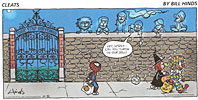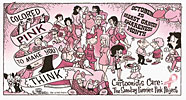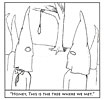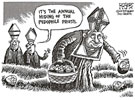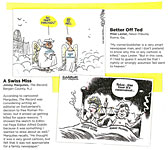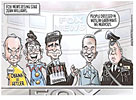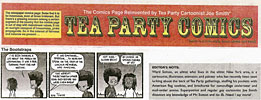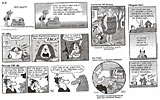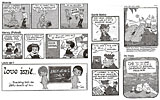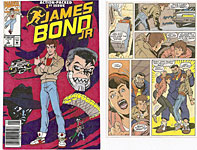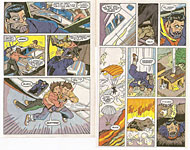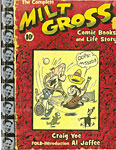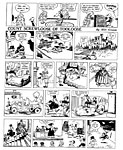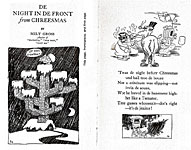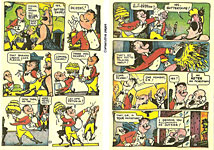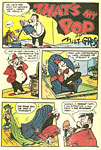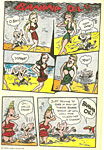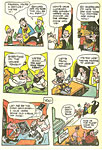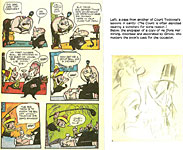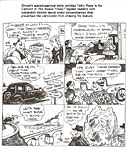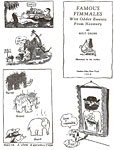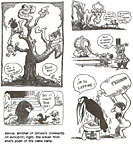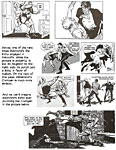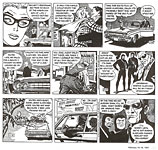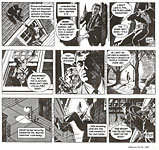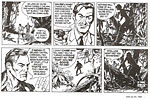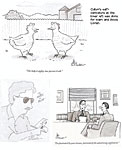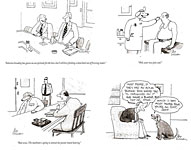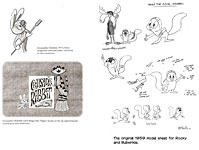 |
|||||||||||||
Opus 269 (November 7, 2010). Our Big Stories this time include reviews of the life and work of Milt Gross as reflected in Craig Yoe’s new book; IDW’s new Secret Agent Corrigan reprint; and appreciations of the work of two cartoonists who left us last month—Leo Cullum and Alex Anderson. Shorter articles on spiked editorial cartoons, candidates to replace Cathy, comic book future as seen from Portand comic shops, an unusually long news report, and more, much more. (Not to mention, in other words, the usual political screed, this time inspired by the recently deceased election.) Here’s what’s here, in order, by department:
NOUS R US Doonesbury in Plethora Great Pumpkin Cleats No More Searching for Cathy’s Successor Portland Foreshadows Comics Future? Homer’s Religion Hip and Hoodie Superman? Cartoons in American Heritage Conan’s 40th at Marvel Comics Turn Pink Hefner Documentary & Playboy Cartoon Count Updated
EDITOONERY Campus Cartooners Chastised Spiked Cartoons
THE FROTH ESTATE Juan Williams Mike Thompson and Bill O’Reilly
RANCID RAVES GALLERY Boobs Covered Tea Party Strips Iron Jaw Returns
Sex in America The Prostitutes of 1880 The Prostitutes of Craigslist
BOOK MARQUEE The Odyssey Graphic Novel
BOOK REVIEWS The Complete Milt Gross: Comics and Life Story Secret Agent Corrigan by Al Williamson and Archie Goodwin
PASSIN’ THROUGH The New Yorker’s Leo Cullum Bullwinkle’s Alex Anderson
And our customary reminder: don’t forget to activate the “Bathroom Button” by clicking on the “print friendly version” so you can print off a copy of just this installment for reading later, at your leisure while enthroned. Without further adieu, then, here we go—
NOUS R US Some of All the News That Gives Us Fits On October 26, Doonesbury reached the 40th anniversary mark, and festivities broke out all over. Rolling Stone’s November 4 issue has a long interview with creator Garry Trudeau, and SLATE is featuring a dozen articles, including several with nicely provocative titles: “Me and Uncle Duke” (“what happened when Hunter Thompson told me Garry Trudeau was spying on him”) by arch conservative Nicholas Von Hoffman; “Uncle Duke is My Hero” by Walter Isaacson; and another interview with Trudeau (on his stamina, the difficulty of satirizing Obama, and “the most bizarre attack on his strip ever"). In addition to all that effusion, two coffee-table style books came out last month: 40: A Doonesbury Retrospective, an 11-pound tome that gathers, according to Trudeau’s estimate in his introduction, a mere ''13 percent of the over 14,000 published strips” accompanied by 18 character essays by the cartoonist; and Doonesbury and the Art of G.B. Trudeau, the only one of the two that I’ve actually seen (272 9.5x11-inch landscape pages, b/w and color; from the University Press of Trudeau’s alma mater, Yale; $49.95) by Brian Walker, who says, at SLATE: “I have long felt that Doonesbury creator Garry Trudeau hasn't received adequate recognition for his talents as an artist and graphic designer. His strip, which earned a reputation for being poorly drawn in its early days, has been one of the most graphically innovative strips on the comics pages since the mid-'80s. And Garry's art has never been confined to the strip. In 1983, I curated the Doonesbury Retrospective at the Museum of Cartoon Art. While researching this exhibition, I had seen illustrations, sketches, and designs Garry had done for special projects. I knew there was a wealth of other material waiting to be uncovered.” And he has uncovered lots of it. This book, which I’ll review at greater (and doubtless more tedious) length later—when I also get my hands on Retrospective—will lay to rest, finally, the contention that Trudeau can’t draw.
SPEAKING OF ANNIVERSARIES, it’s the 50th for Frederico Fellini’s classic “La Dolce Vita.” ... The Cleveland Plain Dealer reported on October 19 that American Splendor creator and Cleveland native Harvey Pekar died July 12th of an accidental overdose of two anti-depressant medicines, according to the Cuyahoga County Coroner's Office. No foul play; but then, I didn’t think there was. Ironic, though—and Pekar would doubtless be the first to appreciate this—that the famously grumpy Pekar should die of anti-depressant meds. ... The next print edition of The Comics Journal, No. 301, has ballooned to about 600 pages, we’re told, and won’t appear until early next year. They vowed the print version would be like a “book,” and it looks like that’s what it’ll be, kimo sable. (Looking at what’s happened to this installment of R&R, I can understand how the subjects being written about sometimes run away with the horse they climbed on, willy nilly.) ... New York magazine reported that Jim Russell, the disgraced GOP House candidate in Westchester who wrote an article warning of the evils of interracial mixing, is suing various journalists for $1 million, alleging that they “smeared his name” by pointing out how racist he is. Among those being sued is Matt Davies, Pulitzer-winning editoonist at the Journal News in White Plains. ... In Entertainment Weekly (Reunions Double Issue): “You know New York Comic-Con has gone to hell when the plushies start showing up” (with a picture of some sort of hairy being—maybe a human in costume? Maybe not?). Howard Kurtz in the Washington Post quoted Jon Stewart who told National Public Radio last month that, in his view at least, he and Glenn Beck are not so different. Said Stewart: "He's a reaction to what he feels like is the news, and so are we. We actually share quite a bit in common in terms of, not point of view necessarily, but reason for being. We're both in some ways an op-ed. We consider ourselves editorial cartoonists in some respect." To which one editooning wag responded: “He's so right, although I'd venture they're really more political cartoon characters than cartoonists, especially if you throw Colbert in there. Still, I think we should all be flattered.” The latest edition of the Guinness World Records, which goes under the 2011 banner, says unequivocally that the San Diego Comic-Con is the world’s largest comic convention. It has other things to say about the comic book firmament, among them, that X-Men No. 1 recorded the highest print-run of any funnybook, 8.1 million. The first graphic novel that called itself a graphic novel was Bloodstar by Robert E. Howard; but others came in close—George Metzer’s Beyond Time; and Red Tide by Jim Steranko. Joe Simon, born in 1913, is the oldest living comic book writer. (I suppose it’s impossible to have the oldest dead comic book writer, so that expression—oldest living, which I deployed here—is tautological. Sorry.) The United Kingdom’s Dandy magazine, launched December 4, 1937 and still publishing, is the longest running weekly comic book; our home-grown Detective Comics, dated March 1937, is the longest running monthly comic book, and it’s older than Dandy. The most banned book, which distinction it has enjoyed every year since 2006, is And Tango Makes Three about two male penguins who raise a baby penguin; the cause of the banning (surely you saw this coming) is that it promotes a homosexual life style. According to an article posted on HuffingtonPost, Homer Marciniak was looking for buyers for his collection that he started when he was six years old. The collection was valued between $40,000 to $100,000. Police suspect that Homer approached Rico Vendetti, a tavern and restaurant owner who once owned a collectibles business and that Vendetti and an accomplice entered Homer’s home to steal the collection. During the robbery Homer was allegedly hit in the face requiring a hospital visit. After police questioning the next day, Homer died of a heart attack.
AMERICA REDOUX The November 5 issue of Entertainment Weekly has Captain America on the cover—namely, Chris Evans, the final choice to play the part in next summer’s movie, wearing the modified iconic costume. Instead of the traditional flag-striped gala, the new uniform mutes the colors, substitutes a leather jacket for the chain-mail, and encumbers the actor with suspicious accessories— leather gloves, boots, and harness with straps, buckles, and belts. No pictures of Evans wearing the helmet with the little wings, though. Evans turned down the part three times because he was afraid it would lock him into the role for his entire career (the contract originally called for him to commit to nine movies in the role; he agreed to six), and when he finally took the leap, the first thing he did was to check the Web to see what Marvel fans thought of the casting. They thought he needed more muscles, so he got some more, and EW, eager to cater to superhero fans everywhere, publishes a photo of Evans with his naked, hairless chest hanging out; impressive with ponderous pecks and big biceps, he’s being filmed exiting Project Rebirth whereby Steve Rogers gets transformed from skinny kid to muscle-bound super soldier. Retailing Captain America’s origin, the movie takes place in the Marvel fantasy of World War II but plays down the flag-waving jingoism of the 1940s comic book tales because Marvel is leery of irritating one or the other of the nation’s current political polarities. Director Joe Johnson wanted a movie “about international cooperation,” and in this re-telling, Captain America is the leader of a team of elite soldiers from various nations. Said co-producer Stephen Broussard: “It’s not about running from [political interpretations] or being afraid of saying anything, but just staying true to what the story has always been. I welcome whatever kind of healthy debate comes from it,” he added, apparently not aware that “healthy” debate is no longer an aspect of American political life. By the time “Captain America: First Avenger” opens July 22, the next of the six movies Evans will play the role in will be into production—“The Avengers,” studded with stars; besides Evans: Robert Downey Jr. (Iron Man), Samuel L. Jackson (Nick Fury), Scarlett Johansson (Black Widow), Mark Ruffalo (Hulk), Jeremy Renner (Hawkeye), and Chris Hemsworth, who will be reprising his role as Thor in the movie of that name that will open three months before “Captain America.” After which, Evans will have four more turns as Cap: two solos in “Captain America” sequels, and two as part of the gang in subsequent “Avengers” films.
WE’LL BE WAITING NEXT YEAR, TOO The Hallowe’en issue of Parade, the Sunday newspaper magazine supplement, celebrates the holiday with an article by Eric Konigsberg about his initial exposure to the Great Pumpkin when he was eight years old. Linus sped his first letter to the gourd god in 1959, and he’s awaited the sanctified arrival in the pumpkin patch every year since—to no avail. “As I child,” Konigsberg writes, “I felt for Linus, whose faith in something unprovable was stingily rewarded, if at all, with the knowledge that he’d maintained his belief in the face of ever-increasing doubt. ... The true genius,” he goes on, “of the Great Pumpkin may be the way it sends up other holiday parables by having a character seek a deeper meaning in the sole holiday that has no real lesson to teach. Is there any other day we celebrate that is as empty of moral or historical significance?” Then, saying that “the story can be seen as an allegory of the irrationality of belief or as a satire of religion,” Konigsberg quotes Charles Schulz’s biographer, David Michaelis: “On some level, Schulz was showing us how some people would so much rather live with this craziness of false belief instead of just being quiet and resolute in their faith. He was saying, ‘Be careful what you believe.’” Or maybe, Konigsberg says, “Schulz might have actually been paying tributre to the gleeful earnestness of Hallowe’en and of childhood itself.” In referring to Michaelis’ Schulz biography, Konigsberg ratifies the belief of many Peanuts fans (and of the cartoonist’s widow and children) that the book tarnished Schulz’s reputation and memory: “the artist lost a degree of luster in the minds of some Americans ... [because he] was portrayed as gloomy and self-absorbed, jarring traits for the creator of such sweetly memorable lines as ‘Happiness is a warm puppy.’” For Konigsberg, however, it was exactly those aspects of Schulz’s personality “that gave us his delightfully frank, slightly cynical body of work.” As you might expect, I don’t agree. Peanuts was the product of all of Schulz’s personality, not just his dark side; and the prevailing comedy was the result of a world view that was essentially playful and joyous, not gloomy. Incidentally, this issue of Parade is missing altogether the cartoon feature, which, lately, has been staggering between one cartoon a week, usually, and, rarely, the customary two or three.
HINDS
HANGS UP CLEATS That's quite different from the “crazy slapstick” in Hinds’ strip for Sports Illustrated, Buzz Beamer, and from Jeff Millar's satirical writing in Tank McNamara. “Speaking of Tank,” Hinds said, “some people couldn't seem to separate Cleats from Tank. The term Tank Lite came up a few times online, and the Cleats writing was occasionally attributed to the innocent Jeff Millar. In the last couple of years the writing in Cleats has become quirkier as I decided to entertain myself. I can't think of a particular strip that stands out in my mind, but Edith and Dee are my favorite characters. By the way, many of the characters in Cleats are based on real people, including Jack's grandmother Bertha who is based on my wife's grandmother Bertha. The real Bertha is in her late 90s, and is disappointed about losing her celebrity status.” The final Cleats, which we post herewith, as promised, is a sweet humorous melding of what might otherwise be ghoulish Hallowe’en themes and the death of a strip whose creator loved it.
SEARCHING FOR CATHY’S SUCCESSOR As soon as Cathy Guisewite announced her impending retirement—and Cathy’s—the comic strip universe began trembling as a scramble commenced among survivors to fill the vacant slot in over 700 newspapers—a virtual windfall of opportunity not experienced since The Far Side ceased on January 1, 1996, a day after Calvin and Hobbes retired. At Editor & Publisher (October’s issue), cartoonist-reporter Rob Tornoe summarized the contest by reviewing the availability of comic strips about women by women, assuming that newspaper editors, known to be a somewhat knee-jerk lot when it comes to their comics sections, would be looking for an exact replacement for the profession’s iconic strip about female issues by a female. Judging from his article, Tornoe sees only four “female-centered” strips that might meet the knee-jerk criteria; and here they are: Rina Piccolo’s Tina’s Groove (launched in 2002), about “a single, smart, attractive waitress ... Shrewdly self-aware, Tina refutes cliched notions of single women as neurotics obsessed with career or [getting married].” Sandra Bell-Lundy’s Between Friends (1994) “celebrates the essence and angst [lovely phrasing—RCH] of three contemporary women friends in their forties ... [who deliberate] about office politics and body image and snicker about their ex-husbands’ girlfriends.” Jan Eliot’s Stone Soup (1995) is about “an extended family living in two households. ... Women may be the central characters of the strip, but its kindness toward men and a wide array of children characters [of different ages]... create a big tent for comics readers of all ages.” And Terri Libenson’s The Pajama Diaries (the newest of the crop; started in about 2006), which appears as illustrated pages of Jill Kaplan’s diary, wherein she records her efforts to “juggle her work [she works at home as a graphic designer], family [husband and two children], and sex life—or lack thereof—without going bonkers.” These are all excellent strips—well-drawn realistic comedy on every hand—and no newspaper editor can go wrong in resorting to one of them to replace Cathy. An obvious candidate, Lynn Johnston’s For Better or For Worse, is probably not eligible: chances are it already appears in most of the papers looking for the next Cathy. Hilary B. Price’s Rhymes with Orange, although by a woman, doesn’t concentrate on women’s issues enough to measure up. Nicole Hollander’s Sylvia is probably too satirically edgy to compete in the same competition. Besides, Sylvia is an “older woman.” But there are two other well-drawn strips with strong young female characters facing contemporary women’s issues in life and, in one, careers. They are both, however, disadvantaged in this age of tit-for-tat so-called thinking because each of them is written and drawn by a male cartoonist. In the alleged minds of too many newspaper editors, Guisewite’s Cathy cannot—heaven forfend!—be replaced by a strip produced by a male sensibility. Too bad: these two are at least a match for any of the others Tornoe mentions—and often regularly surpass them in sensitive humor in arenas of human endeavor that all of us care about. Brooke McEldowney’s 9 Chickweed Lane focuses on the lives and aspirations of three women at that address: the daughter, her mother and her grandmother. The daughter has graduated from high school and is on her own in New York, working in a ballet company, and living with her dancing partner, a gay man; she has entered a romantic relationship with her highschool chum, and a year or so ago, they both lost their virginity in a beautifully comedic but sensitive sequence that lasted weeks. The grandmother has been telling the story of her World War II experiences as a USO entertainer, falling in love with two men (an American and a German), another empathetic and mature narrative that lasted more than ten months—an unheard of achievement with today’s short-attention-span audience. But it was done superbly— suspensefully, tastefully, wonderfully. The mother, a college professor, married a colleague a couple years ago, and their passionate relationship provides an occasional interlude. In my view, 9 Chickweed Lane is one of the two or three very best newspaper comic strips now running (one of the others is Garry Trudeau’s Doonesbury)—mature, realistic storylines with gentle humor, beautifully drawn. Greg Evans’ Luann, which recently celebrated its 25th anniversary, is another of the very best comic strips around. The eponymous Luann, a teenager, faces the usual array of problems (dating, grades) encountered by highschoolers, and she is surrounded by a collection of friends that keep the incidents interesting and engaging and realistic. But it is the romance between her nerdish older brother Brad and his beautiful paramour Toni Daytona that best demonstrates Evans’ gift for witty dialogue and humane dilemmas. Too bad McEldowney and Evans are men. Some newspapers, Tornoe speculates, will not look for a square peg to fit in the rectangular hole Cathy leaves behind. Quoting Alan Gardner at DailyCartoonist.com, Tornoe agrees that some editors “will use this departure to run a near endless stream of comic strip trials, which they can usually run for free until they find a permanent replacement.” Well, maybe. At first, I guessed that the strips by Rina Piccolo, Sandra Bell-Lundy, Jan Eliot and Terri Libenson will be recruited pretty fast. But Gardner found out differently by doing some research. Gardner gathered and analyzed information from several sources to try to find out which strips most benefitted from Guisewite's retirement. First, he consulted the syndicates themselves, asking them to name which three of their strips were selling the best. Here are the results (strips with a * indicate a feature launched this year): Creators: *Dogs of C-Kennel, *Diamond Lil, Free Range; King Features: *Dustin, Zits, Rhymes With Orange; United Media: Pearls Before Swine, *Freshly Squeezed, Big Nate; Universal Uclick: Stone Soup, Cul de Sac, *ThataBaby!; Washington Post Writers Group: Pickles. Only one of Tornoe’s list made it—Stone Soup. But Gardner wasn’t content to let the question dangle solely on the testimony of self-interested syndicates. He also watched Google News for announcements from newspapers about which strips they were putting in Cathy’s place, and he assembled some additional stats from syndicates. He determined that all three sets of data pointed at these three strips as the top contending Cathy replacements: Dustin by Steve Kelly and Jeff Parker; Stone Soup by Jan Eliot; and Pickles by Brian Crane. Gardner cautioned that newspapers do not necessarily replace one strip with another of the same sort. But some do. “For those editors looking for a strong female character, Stone Soup was the go-to strip,” he reports. “Out of curiosity, I added up all the female character strips in the Google News dataset and compared their sales to the total. Papers purchased less than 10% female lead character strips. I wish I had better data regarding how well female strips did. I doubt that the 10% is accurate; it just seems too low, but from anecdotal conversations while at the Festival of Cartoon Art, I have no reason to believe that female strips as a whole did very well compared to all sales.”
STAN LEE GIVES ACTING ADVICE Rick Marshall at MTV News asked Stan Lee what advice the co-creator of Spider-Man might have for actor Andrew Garfield, lately chosen to play the part in the next Web-slinger movie. Said Lee: "The best way to bring Spider-Man to the screen is to make it seem very natural—just to be a very simple, everyday, ordinary kid who happens to be good at science and wishes he were more than he is. He wishes he were more popular with the guys. He wishes the girls would pay a little more attention to him. He wishes he could make more money because he worries about his aunt who has to pay the rent, and it's kind of tough for her. He doesn't want her to lose her house." According to Lee, Marshall said, “the essence of playing a believable Peter Parker is not so much in the super-powers and snappy comebacks, but in finding your inner, awkward teen.” Lee
continued: “He should have the kind of concerns that so many teenagers have.
The thing about Spider-Man, one of the things that makes him so popular, is the
fact that you can relate to him. He's not that different from the average guy,
except he's able to crawl on walls and swing on webs." Lee laughed.
COMICS IN PORTLAND—A GAUGE OF INDUSTRY HEALTH? Erik Henriksen at blogtown.portlandmercury.com, realizing that the comic book industry is “in a state of flux” trying to integrate itself into a digital universe without being quite ready to abandon olde timey print, thinks “what will happen in local comics shops across the country in the next few years will affect any number of things—from the existence of tiny nerdy supply stores in small towns to the omnipresent power of kajillion-dollar superhero blockbusters.” Because Portland, Oregon is “a city that's home to a huge array of comics creators, the Stumptown Comics Festival, publishers like Dark Horse Comics, Oni Press, and Top Shelf Productions, and some of the best comics shops in the world,” Henriksen thought its comics shops might supply insights into the future, so he e-mailed some of their owners and employees and asked them what they thought about the future of the medium and of their business. He was surprised to learn that most of those he talked to “kinda like” digital comics. “They like 'em because they feel digital comics will bring new readers to brick-and-mortar shops,” he said. And then he quoted some of his sources. "Digital comics are here to stay, but it's not going to be a big deal. Just like VHS/Betamax/DVDs/Netflix didn't kill the movie theater, nor will digital comics kill the comic shops," says Michael Ring of Bridge City Comics. "The people that come in looking for comics want to read comics. They want to hold them in their hands and be able to loan them out and pass them down to their kids. Digital comics are great as a low-cost way to sample new series." From a creator's perspective, Steve Lieber sees huge potential for getting the work of comics professionals in front of more readers. "As a freelancer, I don't have access to the numbers that would make it possible to talk about the effects [of digital sales] on brick-and-mortar retailers—but to be honest, I don't think the publishers know either," Lieber says. But that doesn't stand in the way of his enthusiasm. "I'm incredibly eager to see the digital market grow," he says. "There aren't nearly enough brick-and-mortar stores in the US to serve all the people who would like to read comics. Making it easier to get comics is the single best way to expand our readership." Henriksen also got an earful on another hot topic—the cover price of funnybooks. Said Lieber: "Shop-owners I've spoken to have told me that the $3.99 price point was chasing away a number of once-steady customers.” Unsurprisingly, Marvel and DC's recent announcements that they plan to ease up on charging $3.99 per issue have been welcomed by both readers and retailers. Henriksen continued: “With the pricing and the format of comics in motion—and with both of those factors affecting small, local shops—I asked Portland's comics shop owners about the state of the direct market in general. Unlike their responses to digital comics and pricing, their answers were more varied.” "We'd love to see the industry loosen [Diamond Comic Distributors'] virtual monopoly on distribution," say shop operators Allie and Jeremy Tiedeman. "While [Diamond has] a lot of good qualities, it's discouraging to see their monthly catalog brimming with superhero and genre comics but short on a lot of awesome indie stuff. We'd love to see a more well-rounded distribution, whether via Diamond or some other company. We think comics will continue to spread throughout the culture, especially via indie and literary comics and graphic novels. We hope to see the self-publishing market in Portland continue to grow and flourish." At Excalibur, Rosko (whose first—or last?—name I’ve irresponsibly lost; sorry) sees a general increase in comics reading, in part thanks to how successful superhero films have been in recent years. That interest, he says, will keep comics shops around. "Every time an ‘insider' says the industry is going to take a crap, it comes back in a big way. I've been hearing ‘It's all over in five years' for the last 15, and I'm sure they've been saying that longer than that," he says. "That's what makes comics so interesting an industry—it changes and adapts and always finds a way to survive. We've also been noticing kids are coming in, looking to explore comics at an exponential rate. Kids have been devouring the books we give them. They see the characters on TV or in movies, and they want more adventures with their favorite characters. Luckily in some cases there are 40, 50, 70 years' [worth] of material they can read! We also have adults feeling the same way. Comic book characters and storytelling has permeated the popular culture—people more and more are now interested in reading comics."
HOMER’S RELIGION Just as we were approaching that infamous religious holiday, All Hallows Eve (or, as it’s sometimes known, Hallowe’en), came the news that Homer Simpson and the rest of his jaundiced brood are good Catholics, viable candidates, we’d suppose, for celebrating All Hallows Day on November 1. This news arrived through one of the world’s last remaining infallible sources, L’Osservatore Romano, the official newspaper of the Vatican, and if it doesn’t know about Catholicism, who does? In an essay in the paper published October 17 (just as the Festival of Cartoon Art was concluding at the Ohio State University in Columbus), Luca M. Possati supported his contention about the Simpsons by citing a Jesuit priest's study of the 2005 episode, "The Father, the Son and the Holy Guest Star," in which Bart attends a Catholic school and Homer tries out the practice of confession. But Al Jean, an executive producer and show runner of "The Simpsons," disagrees. Quoted at Entertainment Weekly’s website, EW.com, he said the Simpson family attends the First Church of Springfield, which is "Presbylutheran," adding: "We've pretty clearly shown that Homer is not Catholic. I really don't think he could go without eating meat on Fridays—for even an hour." “Catholicism isn't the only religion with a soft spot for Homer and his family,” said David Itzkoff in the New York Times artsbeat.blog: “The Homer Calendar website uses Simpsons characters to illustrate the traditions of Passover and includes many links to discussions about the Jewish content on the show.” Matt Groening, who was a featured speaker at the OSU Festival (a triennial event sponsored by the Billy Ireland Library and Museum of Cartoon Art), was not, I assume, available for comment, but in the Playboy Interview of June 2007, agreed with his interviewer who said “The Simpsons” regularly make fun of religion. Groening remembered an episode during which Homer is chased by a mob, “and Homer runs away, yelling, ‘Save me, Jebus!’ He can’t remember the guy’s name. We also did a parody of a commercial about the new Catholic Church that was shot like a beer commercial.” Scarcely a deferential Catholic attitude, I’d say. But the question was rendered moot a couple of days after Reuters broke the story. BusinessWorldOnline reported that the author of the cited study claimed the Vatican newspaper had misinterpreted his work. "I wouldn't say they're Catholic,”said Francesco Occhetta, a Jesuit priest and staff writer for the Rome-based journal Civilta Cattolica. “I would say they're people of faith." Occhetta, who is also writing a doctoral thesis in moral theology at the Vatican university, said he is an avid viewer of the popular series and can see important spiritual life lessons in the adventures of the Simpson family. Said he: “I would say that the Simpsons are open on the question of God. The authors are fiercely critical of some religious people but they respect faith, openness to God, prayer and going every Sunday to listen to their pastor—even if they sleep or eat popcorn when they go," he added. "There's this idea that faith unites the Simpsons," he continued. "It's not like Walt Disney. They're not just good people or bad people. The characters have both good and evil traits. Just like real life.” And there you have it: a Jesuit priest affirms the reality of the Simpson family.
LYND WARD PRIZE ANNOUNCED In a press release early in October, Penn State University Libraries and the Pennsylvania Center for the Book announced the creation of the Lynd Ward Prize for Graphic Novel of the Year. “The Lynd Ward Graphic Novel Prize honors Ward’s seminal influence in the development of the graphic novel and celebrates the gift of an extensive collection of Ward’s wood engravings, original book illustrations and other graphic art donated to Penn State University Libraries by his daughters, Robin Ward Savage and Nanda Weedon Ward. Between 1929 and 1937 Ward published his six ground-breaking wordless novels—Gods’ Man, Madman’s Drum, Wild Pilgrimage, Prelude to a Million Years, Song without Words and Vertigo,” all of which have been re-issued lately by The Library of America in a two-volume boxed set entitled Lynd Ward: Six Novels in Woodcuts, “the first time the nonprofit publisher has included a graphic novelist in its award-winning series.” The Lynd Ward Prize will be presented annually to the best graphic novel, fiction or non-fiction, published in the previous calendar year in the United States by a living American citizen or resident. The announcement of the award will take place each spring, and the prize of $2,500, the two-volume set of Ward’s novels, and a suitable commemorative will be presented each fall to the winner at a ceremony to be held at Penn State.
JUST HOW HIP IS SUPERMAN THIS TIME? The razzle-dazzle foofaraw began on Monday, October 25, saith Glen Weldon at National Public Radio, with an article in the New York Post, which “touched off a mainstream media firestorm. Outlet after outlet took the bait; many seized the opportunity to make with the hacky hipster jokes, viz: ‘Will the Fortress of Solitude be a Williamsburg Food Co-op?’ Blah blah blah hoodie blah low-cut jeans blah moody blah blah Twilight blah. Good heavens! Will Superman ever be the same? Short answer: Yes.” What got Weldon’s wattles in an uproar is all the publicity suddenly converging on the hardcover graphic novel Superman: Earth One when it hit stores nationwide at the end of October. You have to look twice to comprehend that the character on the cover is Superman/Clark Kent. “The big ‘S’ is still on his chest,” reported the Associated Press, “but the new Superman is not exactly the chipper and bright-eyed optimist of lore.” Probably the AP hasn’t been reading comic books lately; Superman stopped being bright-eyed and chipper even before he married Lois Lane. But AP, undeterred, goes on: “The kid from Kryton [in this book] sports a hoodie, a brooding brow and fashion sense that wouldn’t put him out of place in hipster lairs.” The AP quotes DC Comics co-publisher Dan DiDio: “We always knew that we wanted to do a real, contemporary interpretation of Superman. He's young, he's hip, he's moody. He really fits in with the types of stories people are looking for today," DiDo concluded, interviewed by USA Today, which, in turn, finished: “With writer J. Michael Straczynski at the helm and Shane Davis doing the art, it should be interesting to see where our hero goes.” A super slacker? Weldon rampages on to point out that it’s all happened before: “This is only the latest iteration of the most-told tale in comics—that of Superman's origin. It's a story that exists in a continual state of reinterpolation: in 2009's Superman: Secret Origin, Geoff Johns and Gary Frank retold it in six issues; in 2005's magnificent All-Star Superman, Grant Morrisson and Frank Quitely managed to bust it out in just 4 panels and 8 words: ‘Doomed planet. Desperate scientists. Last hope. Kindly couple.’” The ritual re-telling, like all folk tales, has “been going on for decades, and every time, the cultural touchstones of Clark's youth edge closer and closer to the present day. Over the years, phone booths made way for smart phones. ‘Dese-and-dose’ gangsters morphed gradually into technological terrorists.” The current excitement, in other words, is simply another “variation of the oft-written ‘They're Making a Change to That Thing You Dimly Remember From Childhood Shock Horror!’ story that the media has seized upon since Lincoln Logs went plastic.” Well, yes, Clark Kent in a hoodie is just another in a long and increasingly boring series of make-overs that the Man of Steel has endured over the last forty years. It’s boring to long-time fans because we’ve seen it all before: we know the origin of Superman. And whatever the new take on it, it’s usually a matter of infinitesimal tweaks rather than major overhauls. But this time, I wonder. Looking through the last several issues of Diamond’s Previews catalogue, it’s clear that Batman titles outnumber Superman titles. Perhaps this hardcover re-do of the iconic DC character is a corporate effort to reclaim the company brand from under the grim glint of the Bat signal. The eruption of media attention, after all, was doubtless sparked by publicity releases from DC; the fuss Weldon decries was scarcely a spontaneous generation of interest. Maybe the Powers That Be (the earth-bound, corporate suits, that is—not the caped and spandexed kind) want to restore the company’s patriotic patina by unseating the psychotic Dark Knight and putting the cleaner-cut Superman back on the throne. Maybe. But then again, the hoodie Clark Kent has about him something of the psychotic aura ...
CARTOONS IN AMERICAN HERITAGE The current issue of American Heritage (Fall 2010) uses cartoons as well as photographs to illustrate virtually ever article—origin of the Korean War, capture of Jeff Davis after the Civil War, Congress vs. the President. Editor Edwin S. Grosvenor explains: “Time and again, political satirists and propaganda artists got right to the core of issues we were going to bring alive. Political cartoonists sharpened their editorial knives way back to the earliest days of the Republic, as you’ll see.” Among the cartoons are several embellishing Nat Gertler’s essay on the 60th anniversary of Charles Schulz’s Peanuts. No profound insights herein; just a nicely abbreviated biography of the cartoonist and a short history of the strip and descriptions of the main characters (with only one typo: editorial cartoonist Steve Kelley, whose cartoon on the day after Schulz’s death ends the article, spells his last name with two e’s). But the notable part of the article is the preface by Schulz’s daughter, Amy Schulz Johnson, who writes: “My father signed with United Feature syndicate believing that his job was to help editors sell newspapers. He started in seven papers. Fifty years later, with the strip appearing in a record 2,600 newspapers, Dad still went to work motivated by that same belief. As I grew up, I regarded my father not as Snoopy’s dad but mine. I wasn’t quite convinced he had a real job like other dads: he didn’t go off to work like other dads but worked in a studio on our property in Santa Rosa, California. He never worked past 5 p.m. nor on weekends. His children would think nothing of walking into the studio, right past the secretary, and into his office. I can picture him looking up and immediately putting down his pen to talk to me. He never once asked me to wait while he finished a drawing or some lettering. Whenever my brothers asked him to play baseball—even in the middle of the day—he happily complied. As much as he loved the strip, he loved his children even more. “Life gives birth to pure art, and a true artist pays attention to the details around him—not just the details in his life but in all life. My dad’s gift for observation was proven by the fact that hundreds of millions of people throughout the world would wake up every morning and turn the newspaper page to his strip—nearly 18,000 strips in all—because they had grown to love the characters as real people.” I don’t remember reading any passage like this in David Michaelis’s biography of Schulz.
THE CHARLES SCHULZ FAMILY is launching a few new Peanuts projects. The initial idea after Spark’s death was that the strip would go into perpetual rerun and everything else would stay the same except for contriving new merchandise. But a new animated film is set for release next spring, the Associated Press reports, called “Happiness is a Warm Blanket, Charlie Brown.” And a new “social media game” has begun on Facebook and Twitter and at a popular gaming website for children. Meanwhile, ABC has signed on for five more years of airing Charlie Brown holiday specials.
MORE ANNIVERSARIES GALORE Celebrating
its 40th anniversary right alongside the Overstreet Comic Book Price Guide is Marvel’s Conan the Barbarian. Roy Thomas, one-time editor-in-chief
and longtime Conan scribe, remembers discussing the possibility of adapting
Conan at Marvel: "Stan Lee had no feel for what sword and sorcery
was, but I had bought (though I hadn't read them) all the Conan paperbacks that
had come out to date, largely because of the Frazetta covers."Thomas told
Diamond’s Scoop that he wrote a memo to Marvel publisher Martin
Goodman saying that a sword and sorcery comic would contain some of the
same qualities super-hero comics did—a strong hero, beautiful women, monsters,
and villainous sorcerers. Conan No. 1 sold well, but each of the next half dozen issues dropped in sales.
Thomas recalled Lee stepping in around the eighth issue. "Stan 'suggested'
that we have more humanoid foes for Conan on the covers than giant spiders,
man-headed snakes, apes in armor, and women turning into tigers. With Nos. 8-9
and afterward, the sales [consequently] picked up, and afterwards Conan was
never in danger of cancellation for another 25 or so years." ***** Remember when comedians were leery of making jokes about Baracko Bama (probably because he’s black)? That’s changed. The Associated Press reports that through Labor Day this year, late-night comics Jay Leno, David Letterman, Jon Stewart and Jimmy Fallon joked about O’Bama 309 times. That makes him a laughing stock. Sarah Livingston Palin, with only 137 jokes, was runner-up. You wonder who (or what entity) in these troublesome times bothers to keep such scores. It’s the Center for Media and Public Affairs.
THE RANKS OF PINK At DailyCartoonist.com,
Alan Gardner reported that several King Features comics participated in a
“Cartoonists Care” initiative on Sunday, October 10 (10-10-10, kimo sabe!). In
support of National Breast Cancer Awareness Month, more than 50 of the King
Features strips “turned pink” and a special Dan Piraro Bizarro signature art piece was auctioned off. Each comic strip featured the
internationally recognized pink ribbon for breast cancer awareness, emblazoned
with the tagline “Cartoonists Care.” The pink strips ran in newspapers across
the country and online; you doubtless saw some of them in the Sunday funnies of
your local newspaper on October 10. But you probably didn’t see Piraro’s
special artwork for the campaign. So here it is. “It’s very inspiring to see so many of our cartoonists come together to rally around such an important cause,” said Brendan Burford, comics editor at King Features Syndicate. “Nearly everyone has a connection to this heart-wrenching disease, and we felt it was important to make a powerful statement to help support for Breast Cancer Awareness Month. We could think of no better way to do that than by turning the funny pages pink! We hope the ‘Cartoonists Care’ initiative will help raise awareness and encourage our millions of readers across the country to do whatever they can in the fight against breast cancer.” This is not the first time syndicated cartoonists have come together to help publicize an important cause, Gardner noted. In November 2001, the entire National Cartoonists Society cartooning community participated in Thanks&Giving, in which special cartoons, created for Thanksgiving Day, were auctioned and the proceeds donated to the September 11th Fund, established by The New York Community Trust and United Way of New York City. In April 2008, 45 King Features cartoonists created Earth Day-themed comics to raise awareness for the environment and health of the planet. But the first such effort materialized on Thanksgiving Day 1985. Garry Trudeau, Milton Caniff and Charles Schulz mustered over 175 of their colleagues, each of whom produced for the holiday their usual strip but featured food or being hungry in order to promote reader consciousness of worldwide hunger. Later, all the strips were published in a booklet entitled Comic Relief, the sale of which raised money for Africa’s hungry and homeless. This year’s “Cartoonists Care” participating comic strips include:
Apartment 3-G by Frank Bolle and Margaret Shulock Arctic Circle by Alex Hallatt Baby Blues by Jerry Scott and Rick Kirkman Barney Google & Snuffy Smith by John Rose Beetle Bailey by Mort and Greg Walker The Better Half by Randy Glasbergen Between Friends by Sandra Bell Lundy Bizarro by Dan Piraro Blondie by Dean Young and art by John Marshall The Brilliant Mind Edison Lee by John Hambrock Buckles by David Gilbert Crankshaft by Tom Batiuk and Chuck Ayers Crock by Bill Rechin Curtis by Ray Billingsley DeFlocked by Jeff Corriveau Dennis the Menace by Marcus Hamilton Dustin by Steve Kelley and Jeff Parker Edge City by Terry and Patty LaBan Family Circus by Bil Keane and Jeff Keane Flash Gordon by Jim Keefe Funky Winkerbean by Tom Batiuk Grin & Bear It by Fred Wagner and Ralph Dunagin H”agar the Horrible by Chris Browne Heaven’s Love Thrift Shop by Kevin Frank Hi & Lois by Brian Walker, Greg Walker and Chance Browne Judge Parker by Woody Wilson and Mike Manly The Lockhorns by Bunny Hoest & John Reiner Mallard Fillmore by Bruce Tinsley Mark Trail by Jack Elrod Marvin by Tom Armstrong Mary Worth by Karen Moy and Joe Giella Moose & Molly by Bob Weber Sr. Mother Goose & Grimm by Mike Peters Mutts by Patrick McDonnell My Cage by Ed Power and Melissa DeJesus Ollie & Quentin by Piers Baker Oh, Brother! by Bob Weber, Jr. and Jay Stephens On the Fastrack by Bill Holbrook The Lockhorns by Bunny Hoest and John Reiner The Pajama Diaries by Terri Libenson Pardon My Planet by Vic Lee The Phantom by Tony DePaul and Paul Ryan Popeye by Hy Eisman Pros & Cons by Kieran Meehan Retail by Norm Feuti Rex Morgan M.D. by Woody Wilson and Graham Nolan Rhymes With Orange by Hilary Price Sally Forth by Francesco Marciuliano and Craig MacIntosh Sherman’s Lagoon by Jim Toomey Shoe by Chris Cassatt, Gary Brookins and Susie MacNelly Six Chix (There are six different female cartoonists on this comic, one for each day of the week, but the artwork for Breast Cancer Awareness Month was created by Anne Gibbons) Slylock Fox by Bob Weber Jr. Tina’s Groove by Rina Piccolo Todd the Dinosaur by Patrick Roberts Zippy the Pinhead by Bill Griffith Zits by Jim Borgman and Jerry Scott
MORE EXCITATION AT PLAYBOY I watched the documentary “Hugh Hefner: Playboy, Activist, and Rebel” last month, hoping I’d be able to contradict Michael O’Sullivan at the Washington Post, who said the film left him with an impression of Hefner that “seems less a playboy, activist or rebel than a dirty old man.” The movie, by Brigitte Berman, is highly sympathetic to Hef’s view of himself as not only the founder of an “iconic skin mag, but as a tireless champion of gay and civil rights, free speech and liberty, and as a ferocious opponent of censorship, violence, war, and religious persecution. ... Yes,” O’Sullivan goes on, “he opened—or, rather, kicked down—more than a few doors” and he hardly seems the threat to American social order than his critics, a few of whom appear among the supportive talking heads, want us to believe he is. But Hefner, perpetually attired in his pajamas with a bevy of blonde bimbos less than half his age always awaiting him in his bedroom, seems more satyr than savior. And most of his crusades—for freedom of speech and press and sex, homosexual as well as heterosexual, and feminism and the rest—all serve to support the continued publication of Playboy. These activities of the activist publisher are therefore scarcely unencumbered altruism. He’s not Tom Paine or Mohandas Gandhi. But who of us is? I applaud Hefner’s efforts in keeping the press and speech free, in promoting the feminist causes, and in raising the visibility of African American performers and pin-ups, but why must he persist in perpetuating a persona as an ever-ready stud? He’s 84. It’s time to rest. Most males that age do. But Hef takes Viagra and goes on pumping away as if he were twenty again and working on a mink farm. That’s okay if it gives him pleasure; but why does he feel his public image requires such constant burnishing? Dick Cavett, one of those interviewed, summed up the happiest interpretation of this circumstance, drawling (long pauses between words) that Hef provides “wonderful hope ... to ... men ... over 100.” I was glad, though, to hear Hefner defend his magazine against the threadbare charge of objectifying women. “Of course, they’re sex objects,” Hef snorted. “If they weren’t, the species would die off in a generation.” And men to women are sex objects, too. Female lust is inspired by different parts of the male anatomy—the butt rather than the boobs, say, hirsuteness rather than naked flesh—but neither gender is immune from the charge that is so often leveled at Playboy alone. By the way (although not at all incidentally), the current (November) issue of Playboy has a total of 14 cartoons—5 full-pagers and 9 smaller, plus the “pin-up cartoon” of Olivia and two strips, each a half page (Dirty Duck) or less (Meaty Myths). In May and July, the last two issues I did a count in, the total was 12 (4 full-pagers and 8 smaller), so this issue may represent an improvement, however slight. The page-count is higher—138 vs. 126/130; and the ratio of cartoons to pages is better this time: 1/27 for full-pagers vs. 1/32 in May and July (that is, one full-page cartoon for every 27 pages in November); 1/15 for smaller cartoons vs. 1/16 in May and July.
***** Apropos by reason of both preoccupation and vicinity—Bob Guccione, founder of Penthouse magazine, died October 20 at 79 in Plano, Texas, after a long struggle with cancer. Following a failed teen marriage, Brooklyn-born Guccione drifted around Europe and North Africa, “sketching café patrons” until, settling in London, he decided in 1965 at the age of 35 to challenge Playboy. While Playboy had spawned a host of copy-cats, most were cheap imitations, but Penthouse easily matched its inspiration in gloss and literate (albeit somewhat more lascivious) content. Guccione modified his mockery in a significant way, noted Time: the Penthouse models were not “the girl next door” of Playboy fixation; instead, they were decidedly “naughty, looking away from the camera to emphasize the magazine’s ‘voyeurism.’” Penthouse was the most successful of the Playboy entourage, and upon this foundation, Guccione built a pornographic empire, General Media, Inc., which, by 1982, yielded him a net worth of $400 million. But in later years, he lost most of his fortune through bad investments and risky ventures. General Media filed for bankruptcy in 2003, and creditors descended on Guccione’s lavish Manhattan townhouse, auctioning off its furnishings. The one-time porn mogul spent his last years on a much less extravagant scale of living.
FUTURE EVENTS CAST SHADOWS BEFORE I attended the 10th triennial (once every three years, aristotle) Festival of Cartoon Art staged by the Billy Ireland Cartoon Library and Museum (once, back in the yawn of time, dubbed the Milton Caniff Research Room because when he donated his papers and original art to his alma mater that collection was the foundation of the present edifice) October 15-16. I’ll have a report next time. But I’ll mention now that one of the presenters at the comics confabulation was one-time DC president, Paul Levitz, who said he’d been signed on by Taschen to supply text for the illustrations the publisher had assembled for the gigantic 75 Years of DC Comics tome; and he supplied 300,000 words for 20,000 illustrations, he said. He also said Taschen is printing 250,000 of the book, a whopping number—probably anticipating huge sales in Europe, where Taschen hangs its hat. Yes, I know: I promised a review of NBM books this time, coupled to a short history of the publisher. But I’ve been overwhelmed, as you can plainly tell; so, next time. Next time, too, some of the cartoons Ted Rall and Matt Bors did about their Afghan jaunt, and a few of their comments. AND—a report on the annual so-called “Cartoon Issue” of The New Yorker. And more, much more (as usual). Before Christmas, I’ll tell you about my visit in early October to the Fred Harman Museum in Pagosa Springs, Colorado, where the creator of Red Ryder and Little Beaver returned to oil painting to finish his career.
Fascinating Footnit. Much of the news retailed in the foregoing segment is culled from articles eventually indexed at rpi.edu/~bulloj/comxbib.html, the Comics Research Bibliography, maintained by Michael Rhode, which covers comic books, comic strips, animation, caricature, cartoons, bandes dessinees and related topics. It also provides links to numerous other sites that delve deeply into cartooning topics. Three other sites laden with cartooning news and lore are Mark Evanier’s povonline.com, Alan Gardner’s DailyCartoonist.com, and Tom Spurgeon’s comicsreporter.com. And then there’s Mike Rhode’s ComicsDC blog, comicsdc.blogspot.com and Michael Cavna at voices.washingtonpost.com./comic-riffs . For delving into the history of our beloved medium, you can’t go wrong by visiting Allan Holtz’s strippersguide.blogspot.com, where Allan regularly posts rare findings from his forays into the vast reaches of newspaper microfilm files hither and yon.
QUOTES & MOTS “Go confidently in the direction of your dreams. Live the life you have imagined.”—Henry David Thoreau "Life is not a journey to the grave with the intention of arriving safely in one pretty and well-preserved piece, but to skid across the line broadside, thoroughly used up, shouting 'Geronimo!'"—Hunter S. Thompson “Linguists have discovered a new language spoken by a remote tribe in India that’s understood by only 1,000 people. I believe the language is called ‘tech support.’”---Jay Leno
EDITOONERY Afflicting the Comfortable and Comforting the Afflicted CENSORSHIP OR EDITING: CALL IT WHAT YOU WILL Two cartoons published in September in the Daily Campus, student newspaper at the University of Connecticut, touched off an outcry on campus. Victory Lap by Zack Wussow carried the message, "Forget sugar and spice and everything nice. Try crabs, scabs and everything viral. That's what girls are really made of." The other comic, Milksteak and Jellybeans by Alex Dellin, showed a male tossing a diamond ring into a bedroom, while a girl, tongue hanging out, chases after it. The cartoon, reported ctnow.com, implied that the diamond ring—or maybe the promise of marriage—had persuaded the girl to have sex. Nellie Stagg, a student, wrote in her letter to the paper: "Your writers' flagrant disrespect of women and approval of the rape culture that we live in has given me reasonable belief to discredit your entire operation." Miranda DePoi, a junior who is a teaching assistant with the Violence Against Women Prevention Program, said of the cartoons: "They weren't witty, they weren't clever. It was a complete and total disrespect of my gender. … I thought the image of the girl running into the bedroom with her tongue hanging out was very degrading." Cartoonist Dellin, a senior, said he was sorry if people were offended by the Milksteak and Jellybeans episode, but he thinks the connection that some have made between his cartoon and sexual assault is farfetched. "It was a play on an old cliché," said Dellin. "There's a sleazy guy trying to get laid, a girl he's trying to dupe, if you will. … The whole point was: this doesn't work. Obviously, this doesn't work. At some point, it's kind of ridiculous that I can't make a little ring joke in the commentary section." I dunno: an eager-looking girl with her tongue hanging out doesn’t look like Dellin was trying to say the ring on the bed “doesn’t work.” Wussow, the creator of Victory Lap, submitted a statement to the Daily Campus that "what was meant as an absurd exaggeration appeared to many as a literal statement. Most of the time, people seem to get what I'm saying. This time, it really missed the mark." That’s the trouble with irony and satire, Wuss: it often looks like a literal statement. The Daily Campus editor, John Kennedy, said his staff will be working on a "stronger policy" regarding what is allowed into print, and staff will attend workshop on violence against women.
ELSEWHERE,
the Eastern Echo, the campus newspaper at Eastern Michigan University,
had the inordinate temerity to publish the cartoon we’ve posted in this
vicinity, and, according to Melissa Lutomski of the Echo, people at the
University and, I assume, in town got their shorts all bunched up over it
enough to prompt serious responses from the University administration and the
paper’s editors. Said the editors: "We understand the cartoon may have offended some readers. We apologize for the lack of sensitivity some felt we showed for publishing the cartoonist's work. The cartoon points out the hypocrisy of hate-filled people. Its intent was to ask how can someone show affection for one person while at the same time hating someone else enough to commit such a heinous act as hanging.” The cartoon reeked of irony, but irony, as we’ve seen in Connecticut, is tough for some people to process. Apparently, lots didn’t process it here. The editors continued: “We wish to remind readers that they are free to express their opinion on our discussion boards and we hope to continue to foster free thought and open discussion on campus and in the community." EMU’s management chimed in with support for a student free press (doubling as CYA for the administration): "The students are responsible for writing and editing the entire newspaper. The University does not exercise any editorial control over the content of the newspaper. The University does not condone or support any actions that are racially offensive or insensitive." Most of the comments I read online at wxyz.com supported the paper.
NEWSPAPER EDITORS, whether on college campuses or elsewhere, run the risk of raising reader ire every time they publish an editorial cartoon. Editorial cartoonists express points of view—vividly and often simplistically (that’s what cartoons are supposed to do; and they’re good at it)—and some readers might not agree with the point of view (or the simplicity of the imagery). They might, as a consequence, phone the paper’s editor to complain about the cartoon, consuming valuable time that the editor would otherwise be devoting to the latest escapades of Paris Hilton or to the marble-mouthed bromides of John Boehner. And editors don’t like anyone to impose upon the way they choose to spend their editor energies. So sometimes, rather than risk the aforementioned ire, editors just spike a cartoon they think might offend enough readers to take them away from Important Stuff. Here’s
one that Rob Rogers did last year. His editor at the Pittsburgh
Post-Gazette spiked it, but it avoided crucifixion by escaping through the
syndicate pipeline. Others
of Rogers confreres aren’t usually that lucky when they get one of their
favorites spiked. In its September issue, Editor & Publisher ran a
gallery of half-a-dozen editoons “deemed by editors to be too ‘hot’ to run.”
Here they are, and attached to them are the cartoonists’ explanations for the
short lives of their creations. The subject of spiked editorial cartoons is given book-length treatment by David Wallis in Killed Cartoons: Casualties from the War on Free Expression, a 2007 paperback (290 6x8-inch pages; Norton, $15.95) that examines scores of cartoons that never made it into print in their newspapers; most of them are of fairly recent vintage. Fascinating reading.
THE FROTH ESTATE The Alleged News Institution If you pay any attention to the tv news reports about NPR’s firing of analyst Juan Williams, you’d think he was fired for saying something inappropriate about Muslims. According to Matea Gold of the Chicago Tribune, here’s what Williams said in a discussion with Bill O’Reilly: “I mean—look, Bill, I’m not a bigot. ... But when I get on a plane, I got to tell you, if I see people who are in Muslim garb and I think, you know, they’re identifying themselves fist and foremost as Muslims, I get worried. I get nervous.” He also immediately noted that it was not fair to see all Muslims as extremists. No matter. These days, you don’t want to say anything inappropriate about Muslims because a radical few of them, suffering from too tender sensibilities, go all bloodthirsty when you do. So NPR, anxious not to have its blood spilt, severed its connection with Williams. But that wasn’t the Real Reason Williams was fired. The Real Reason was that Williams’ remarks “were inconsistent with NPR’s editorial standards and practices and undermined his credibility as a news analyst with NPR,” according to an official statement from the network. And what are those standards and practices? In the initial reports, no one (except Matea Gold) cited them. I watched an analytical discussion of the matter on PBS’s “NewsHour” the other night, and none of the “experts” said what those practices might be. Not even a sister operation in the media defended NPR. One could well go away supposing that it was the Muslim name-calling that got Williams canned. But not according to Gold. Gold quotes Dana Davis Rehm, NPR’s senior vice president for communication, who said Williams’ comments “violated internal ethics policies that prohibit NPR journalists from going on other media and expressing ‘views they would not air in their role as an NPR journalist.’ The guidelines also prohibit NPR journalists from participating in programs ‘that encourage punditry and speculation rather than fact-based analysis.’” So Williams was actually fired because he expressed opinions—any opinion, liberal or conservative—that would get him fired had he expressed them on NPR. But Williams has been under contract at Fox as well as NPR for some time, years maybe. How come NPR didn’t have any second thoughts about that arrangement? Did management there actually believe that Williams could go on Fox, a hotbed of journalistic opinion posing as news, and not express views that he wouldn’t express on the air at NPR? Seems like NPR should have terminated Williams’ contract at the time he started moonlighting over at Fox. Why wait until now? Probably it was, after all, the Muslim business. That expression of opinion made Williams a little more visible than any other opinion he might’ve expressed on Fox before this. And another factor looms. NPR as well as PBS is constantly under fire from the Right for being left-leaning rather than “objective” in reporting the news. This criticism is a knee-jerk reaction by right-wingers to the criticism they hear about Fox being slanted to the right. If Fox veers off to the right, say the Fox fans, so what? —PBS/NPR veers off to the left, so we’re even. My guess is that PBS/NPR works pretty hard to avoid appearing to favor the Left (or the Liberal or the Progressive or the Right). In other words, they make a concentrated effort to be as “objective” as they claim to be. They want not only to be objective in covering the news: they want to appear objective. And if one of their employees goes over to another network and starts making noises that are far from objective, PBS/NPR gets nervous. That’s exactly what they want to avoid—any appearance that their journalists harbor opinions that might affect how they report the news. Williams fell into that hole. He fell into it the minute he accepted the moonlighting gig at Fox, but, well, you don’t want to fire him because it might appear that you are racist. So you hold your piece. But this time, Williams just went too far. Still, in all the muddle, I think NPR would have been smarter not to fire Williams. It just looks bad. What NPR intended as an assertion of its objectivity came out as a liberal attack on conservative free speech.
OH—BEFORE WE LEAVE
THE SUBJECT, here at hand is Mike Thompson’s cartoon on this infamous
episode. It may be the most accurate portrayal of the Foxes that we’ve had yet.
I’ve always thought Bill O’Reilly is just a joke of a journalist. But he isn’t
just a joke here: he’s a caricature. And so are they all. Thompson’s cartoon—happily, the goal of every editoonist—got under one of its target’s skin. O’Reilly was upset. And so he fulminated on the air about Thompson: “Believe me when I tell you the far left is seething over all of this NPR stuff,” he said. “The blowback has begun. Take a look at this political cartoon in the Detroit Free Press by Mike Thompson featuring me wearing ‘Obama equals Hitler’ stuff.” Then O’Reilly fomented what he conceived as a response fitting the crime: “Please don’t sink to his level,” he cautioned his viewers, “but can you let him know what you think?” Then he gave Thompson’s e-mail address on air. “Keep it respectful,” Old Bill said, “don’t be like Mike.” For days, O’Reilly had been frothing at the mouth about the unprofessional behavior of NPR in firing Williams: a journalist, O’Reilly averred, should not be fired for speaking his mind. No, apparently—if we are to judge from what transpired— a journalist who speaks his mind should have his e-mail inbox crammed with threatening, disparaging e-missives. (Or, in O’Reilly’s case, with bundles of loofahs.) Thompson weighed in a few days later at his blog (in italics):
O’Reilly stressed that his viewers should take the high road in their e-mails to me, which is a little like placing a bowl of Halloween candy in front of kids and telling them not to gorge themselves. O’Reilly’s smart enough to know what would happen. E-mail me they did, more than 2,500 e-mails, many of them unsuitable to publish here, clogged my inbox. I bring this up not because I’m upset; I’ve grown pretty much immune to insults after 20 years in my profession and realize that I forfeit the right to complain about getting bopped in the nose when I voluntarily step into a boxing ring. Besides, I’d like to thank O’Reilly for the significant bump in traffic to my blog. No, I bring this up because I find it strange that O’Reilly and some of his followers fail to grasp the irony of their actions. While defending Williams’ right to free speech, O'Reilly and a number of his viewers tried and failed to bully me for exercising my right to free speech. What it all boils down to for people who behave like this isn’t defending the concept of free speech, rather defending free speech that agrees with their partisan point of view. Many of them decry Williams losing his job because, in their view, he was too conservative. But they want to defund NPR and cause everyone else at the broadcasting company to lose their jobs because, in their view, NPR employees are too liberal. Many of them would stand silently next to people carrying “Obama = Hitler” signs at Tea Party rallies that O'Reilly encourages and promotes, but scream foul when I put the slogan on his shirt in a cartoon. These same people decry what they see as a journalist being punished because of political correctness, then turn around and exercise their own form of political correctness by sending torrents of disparaging and threatening e-mails in a failed attempt to intimidate a journalist who doesn’t agree with their worldview. Then Thompson samples his incoming e-mails:
“I’m not suppose to stupe to your low level. but oh what the hell. I will . I’d like to kick your left wing a--.” “I did not find your cartoon of the NPR firing scenario of Juan Williams to be fair and I will try my hardest to get you fired.” “I had seen your comic strip on Oreille. Your views make you look like a buffoon and a pinhead.” “To call you a scumbag would seriously denigrate all self-respecting scumbags, so I won't do that. You are in-fact a double-douche bag, but I have the same concern..." "I CANT WAIT TO PISS ON YOUR GRAVE...," “YOU CAN'T SEEM TO APPRECIATE AMERICA SO GO TO ANOTHER COUNTRY!!!!!!! FREEDOM OF SPEECH!”
Finally, Thompson concludes (in italics): It goes without saying that O’Reilly has the right to voice his opinions, just as I have the right to voice mine. But his request to his viewers that they carpet bomb me with e-mails was clearly a rather weak attempt to attach a punitive consequence to me speaking my mind. I just hope O’Reilly and his followers can grasp the irony of doing so while simultaneously complaining about NPR attaching a punitive consequence to Williams speaking his mind.
PERSIFLAGE AND FURBELOWS Mell Lazarus, interviewed in one of last spring’s issues of the newsletter of the Comic Art Professional Society (CAPS), said about his career: “I created Miss Peach in 1957, wrote and drew it until 2002, when I retired the feature. Momma got started in 1970, which had me writing and drawing the two features concurrently until I retired Miss Peach. If my arithmetic serves me, it comes to a total of 85 comic strip years, so far. That means, I’ve produced around 31,025 strips (except for a total of perhaps 9-10 weeks of vacation reprints).”
RANCID RAVES GALLERY Pictures Without Too Many Words Here are a
couple bimbo covers of forthcoming funnybooks. Don’t misunderstand: I love ’em,
and that’s why I’ve posted them here. Mostly, however, we’re celebrating the
happy coincidence that they appeared in the same issue of Previews. The
Bomb Queen display is delightfully, hilariously outrageous! Just like the
interiors of the books. Tank Girl is somewhat more demure, but still,
seductive. Finally, remember the Tea Party comic strips? Comics with a tea-flavored slant? Concocted by Ward Sutton with Joe Smith on ink-and-instrument? We posted a couple examples last time; now, here’s the whole enchilada, lifted from the pages of Funny Times, a monthly 24 ad-free-page newspaper of comic strips, editorial cartoons and humor columns that is currently celebrating its 25th year with a circulation of about 70,000 or so. You can subscribe (and I recommend it) at funnytimes.com; $25/12 monthly issues. Now, here are those Tea-time comic strip parodies.
When I was cobbling up the Hindsight report last month on the fearsome Iron Jaw of Gleason’s Golden Age Boy Comics, I didn’t realize that this brute who made a comic book career out of returning from the dead had done it again: in January 1992, a villainous character called simply Jaw showed up in the inaugural issue of James Bond Jr. Same scenario—youthful crimebuster and hulking monster with metallic mandible. I ran across the first issue during one of my periodic prowls of flea markets, and there was old Iron Jaw himself on the cover. See for yourself. James Bond Jr. ran for another 11 issues until the end of the year; dunno if “Jaw” returned after his parachute accident in the No. 1, but my guess he did.
CIVILIZATION’S LAST OUTPOST One of a kind beats everything. —Dennis Miller adv.
SEX IN AMERICA In late September, my wife and I journeyed across Colorado into the largest designated wilderness area in the state wherein, at its center, we stopped at Lake City, the only incorporated municipality in Hinsdale County. En route, the towering vistas on all sides were quivering gently with autumn’s yellow leaf laughter, the green velvet of the pine-covered mountain slopes flecked and often aflame with patches of aspen trees, turned bright yellow and sometimes orange against the green. This annual pageant is one of Colorado’s most spectacular, and every year, Coloradans turn out by the thousands to cruise the canyons and passes in order to witness it. Our views, on this jaunt, were further enhanced by the snowfall of the previous evening, which capped the distant peaks with white—yellow, green, and white, mountain majesty. Lake
City is a tiny town (pop. 375), just a notch above a village: it is today what
Aspen was when I first went there 60 years ago, before it became a haven for
celebrities—a nearly abandoned remnant of bygone glories as a mining “camp” (as
such settlements were called when they cropped up in the 19th century). Some of
the houses are Victorian mansions, gussied up a little by their current owners;
some were Victorian cottages, gussied up likewise. At a tiny steepled church at
the end of a street at the foot of a mountain slope, the sign read: Standing
Tall on Bluff Street. With a few aspen in yellow leaf up the hillside behind
it. Late in the afternoon, almost closing time, I sauntered down the main street. On both sides, 19th century storefronts had become inhabited by 20th century businesses, some, like the hardware store, supplying the needs of the citizenry; others, like antique and collectible shops, tempting tourists. I stopped to inspect the display in the windows of one shop, the signboard of which proclaimed it Artists Cooperative. In one corner of the window was a poster that read: Trollops Framed. I was pondering the import of this information when the proprietor of the shop stepped out to enjoy a few moments of late afternoon air. “What’s this mean?” I said, pointing to the sign. “Come in,” he said, “—I’ll show you.” His art, it turned out, was collecting and framing antique documents—maps and public papers of various kinds. He pointed to the wall where a picture frame embraced what looked like an old ledger-page. It was, he explained, a page of the 1880 census of Lake City, the page that listed the occupants of one of the town’s many saloons. About 10 names adorned the page, 2 men and 8 women. The men gave their occupations as “saloon keeper”; the women, as “prostitute.” I marveled out loud that the whores of yesteryear would be so forthright as to identify their occupations so unabashedly. The man smiled. “Oh, yes,” he said, “they all did, all over the country. According to the 1880 census, there were 2,800 prostitutes in the United States that year. Most of them were in California,” he continued with a grin, “but there were 80 in Colorado, 60 in Leadville [a famous mining camp of that era]. But Lake City had almost all the rest, 8.” Later, pondering these figures, I questioned them. Denver had a fairly active red light district in those days, and I’m sure it was home to more than the remaining 12. But I didn’t think of that until I’d left the shop and its tart enthusiast. “These saloon keepers,” he gestured at the framed document, “were later jailed for some offense— but not keeping a brothel, which is what their saloon was upstairs.” Five years later, in 1885, Colorado conducted its own state census, he said. And the same 8 women were still at work at their 1880 place of business, but this time, they all gave their occupations as “dress maker.” They got religion in just five years. Another sign caught my eye. “Men Taken In and Done For.” It was apparently part of the exterior furnishings of the aforementioned saloon. “If you had to ask what the sign meant,” my informant explained, “they said it referred to laundry.” In various corners of our modern, up-to-date 21st century society, we’re almost as forthright about prostitution as we were in the 1880s. Craigslist, for instance achieved notoriety for its “adult services” section, but the classifieds behemoth has lately shut down this section, pasting a “censored” label over it: the management was reacting to adverse public opinion and pressure from 18 states attorneys general, all of whom objected to the ads for prostitution, saying Craigslist was pimping in a virtual red light district. One of the prostitutes, Melissa Petro, writing at HuffingtonPost (and quoted in The Week) said she had a different perspective. “I was a bored, uninhibited graduate student in need of extra cash, so I advertised my services on the site. By carefully scrutinizing the responses, I screened my ‘dates,’ and best of all, kept every penny I earned. Renting my body to strangers wasn’t much fun,” she admitted, “—in fact, it was emotionally taxing and spiritually bankrupting, which is why I quit. But if consenting adults are involved, it’s not the state’s responsibility—not its right, in fact—to protect people like me from our own decisions. Whether I go on Craigslist to sell a couch or myself is my business.” In another issue—off on a related tangent, I ween—The Week reported October 1 that Men’s Health magazine rated American cities according to how much sex takes place in them. “Seven of the top 15 cities were in Texas, including No. 1, Austin.” In determining the temperature of a city’s six drives, the magazine took into account “condom sales, birth rates, sex-toy sales, and STD rates.” That the ranking was conducted by Men’s Health says something, I reckon, about what is healthy for men. But don’t tell anyone I said so.
***** “Raw Data,” a regular feature in Playboy, recently made the following report (which seems somehow pertinent here): “Up to 80% of women admit to faking orgasms to speed up their partner’s ejaculation because they are bored, tired or in a rush; and 87% of women said they exaggerate pleasure with moans and vocal exclamation because they want to be nice and boost their partner’s self-esteem.” But anyone who’s seen “When Harry Met Sally” already knew. Mostly.
***** ELIOT SPITZER, THE ERSTWHILE GOVERNOR of New York who defrocked himself when his dalliances with a call girl were divulged, has returned to public life---this time, as half host of a CNN talk show; the other half is Kathleen Parker. Which development prompted Laura Kipnis at the Washington Post to observe that Spitzer is not alone in his absolute shamelessness. Take Spitzer’s call girl, f’instance: she is now an columnist at the New York Post, dispensing advice to the lovelorn. But it scarcely ends with this pair, Kipnis goes on: “Family values champion Newt Gingrich continues to pursue the limelight, even after he was exposed as a serial adulterer. [He converted to Roman Catholicism after his third marriage and persuaded the Church to annul his previous marriages; wotta guy!) Even dog torturer Michael Vick of the Philadelphia Eagles has been restored to the pedestal of stardom. With no universal standard of immorality, we no longer put sinners in the stocks. Instead, we put them on tv, forcing them to perform their contributions as mass entertainment.”
***** GAPTOOTHED MODELS are now all the rage, saith Jessica Yadegaran at the Contra Costa Times. That little open space in the middle of the upper dental line-up of a toothy smile (for which Lauren Hutton became famous some years ago but that no other models apparently could duplicate—until now), called a “midline diastema” by practitioners of the dark dentistry arts, is on display on fashion runways all over the place. And last month, Yadegaran reports, on “America’s Next Top Model,” host Tyra Banks sent a 22-year-old contestant from Boise, Idaho, to the dentist to widen her gap. The beauty blogosphere has been buzzing ever since.
***** IN BOULDER, COLORADO, as many as 8,000 of the faux undead were expected at the Zombie Crawl on Saturday, October 23. At the University of Colorado at Boulder, Stephen Graham Jones teaches a course in zombie lore (English 3246). He also teaches Zombie Defense Tactics, or ZDT. The popularity of zombies has been on the rise, he claims, since 9/11. “This year is very zombie-rich. The vampire is just too civilized, elite.” Interviewed by the Denver Post’s Bill Husted, Jones says the great thing about zombies is that they have no responsibilities: “When you’re a zombie, all you have to do is eat. You don’t have to worry about the world anymore.” To which Husted reposited: “Now I get it. If you’re a vampire, you’re in relationships. If you’re a zombie, you just walk around stiff-legged and eat people. The choice is obvious.”
BOOK MARQUEE Previews and Proclamations of Coming Attractions Gareth Hinds, whose self-published graphic novel of Beowulf attracted the attention of the publisher Candlewick, continues his self-imposed project of reinterpreting classic texts in the graphic novel format with his 256-page version of The Odyssey in watercolor and pastel. Hinds and Candlewick hope to find a wide audience in schools and libraries, while still appealing to adults. Since Beowulf, Candlewick has also published Hinds' takes on “King Lear” and “The Merchant of Venice,” the latter of which Hinds had also previously self-published. Hinds notes he is attracted to classic texts because they "have so much depth that I can delve into."
MOTS & QUOTES “A bird does not sing because it has an answer. A bird sings because it has a song.”—Anonymous “Take time to laugh: it is the music of the soul.”—Ditto “We tell ourselves stories in order to lie.” —Joan Didion “Faith is taking the first step even when you don’t see the whole staircase.”—Martin Luther King, Jr. “There are years that ask questions and years that answer.”—Zora Neale Hurston
BOOK REVIEWS Critiques & Crotchets
Milt Gross in a Brand New Tome With his
characters’ ludicrously bug-eyed bulb-nosed physiognomy, sausage-fingered hands
and pancake flat feet, Milt Gross may be said in his drawing style to
epitomize “cartooning.” Dunn further testified to Gross’s “unique way of breaking in a pen nib,” as furious and frantic as his way of drawing: “He used a No. 296 Gillott, and when he replaced an old nib with a new one in the holder, he would hold the pen as if writing or drawing and then like a barber strops a razor, he would whip the pen back and forth on the bare wood of the drawing board. That’s how he got the juicy line he liked.” In his life, Gross was creative profusion incarnate, producing not only a looney gaggle of comic strips but several risible prose works and, as the piece de resistance, a tome that some have dubbed the first so-called graphic novel. In the 1920s and 1930s, he was also an authentic celebrity, Yoe reports, a uproariously funny speaker who was sometimes compared to Will Rogers. Once, after being introduced by a particularly gushing master of ceremonies, Gross leaped to his feet and declared: “I am also a notary public!” He then went on in the same vein, claiming he had been invited to Atlantic City to address six thousand envelopes. Gross
worked in animation, briefly, and, even more briefly, in comic books. Very
little of his comic strip oeuvre has been collected and preserved in book form,
but now, thanks to Yoe Books, virtually all of Gross’s comic book output has
been carefully harvested and preserved between the covers of a single
voluminous tome (356 8.5x11-inch pages, color; IDW, $39.99). The Complete
Milt Gross, Comic Books and Life Story is not only impressively
compendious: with a battered-book cover design, it also presents itself as a
long-lost treasure only recently discovered in a trunk in someone’s attic. And,
indeed, some of it is almost exactly that. For the book’s 40-page biographical introduction, Yoe had access to Gross’s papers, letters and career memorabilia in the custody of Gross’s son Herb and other members of the family. Culling from this trove, Yoe has enhanced the biographical value of his essay with rare visual artifacts, drawings and photographs and copies of newspaper clippings and magazine articles. Yoe also interviewed members of the Gross family and nearly a dozen of the people Gross worked with and/or for in his long career, making the Life Story part of the volume the most complete, accurate and insightful treatment Gross has received. Gross’s life and career are rehearsed in Harv’s Hindsight for May 2006, so I won’t repeat all that now. Instead, here, I’ll insinuate into relevant excerpts of that recitation some of the data I just mined from Yoe’s excellent treatment. Born March 4, 1895 in New York City, Gross left formal schooling at sixteen, taking a job as an office boy in the art department of William Randolph Hearst’s New York American, where he met such cartooning luminaries as Abie the Agent’s Harry Hershfeld, Bringing Up Father’s George McManus, Happy Hooligan’s Frederick Opper, Krazy Kat’s George Herriman, The Katzenjammer Kids’ Rudolph Dirks, Sherlocko the Monk’s Gus Mager, Jerry on the Job’s Walter Hoban, Us Boys’ Tom McNamara, Polly and Her Pals’ Cliff Sterrett, Little Nemo’s Winsor McCay, and Indoor Sports’ Thomas Aloysius Dorgan, who signed his cartoons “Tad” and who called Gross “Davenport” because the youth idolized the work of Hearst editorial cartoonist Homer Davenport. On occasion, Yoe points out, Gross would recall the halcyon days of his office boyhood: “I remember it was predicted that I would either turn out to be something fairly good or end up a terrible bum. I guess I was a petty tough egg in those days, and it must have been a struggle for them not to kick me out of every place. I was a shiftless, irresponsible, wise-cracking kid in whom there was nothing worthwhile but the faint, distant glimmer of an idea, a dream.” The dream involved drawing. Gross, who at an early age had demonstrated an artistic bent, was in his element in the newspaper’s art department, and he was often able to put his pen to good use: “I used to ghost for artists who were late with their assignments,” he told Martin Sheridan in Comics and Their Creators. He did more than that. According to Ari Y. Kelman in his introduction to a 2010 collection of Grossiana, Is Dis A System?, the young would-be cartoonist also illustrated “the most humorous, off-beat, funny human-interest and occasionally off-color news items” he found in the fodder for the newspaper, which, it being a Hearst paper, “proved easy to come by. Often Gross culled headlines, added illustrations, and created a kind of one-panel cartoon that blended real news with his fanciful imagination. Typically, they sounded something like this: ‘The Humane Society got after Senator Snifter last night for leaving his gin where the cats could get at it.’ Or this: ‘Mortimer Mitzic screamingly promised never again to use the vacuum cleaner to remove snow from the sidewalk.’ ... Gross blended fictional and actual newsstories, sometimes making it difficult to tell the difference.” With these specimens, Gross discovered and nurtured a parodical sensibility that would be on display throughout his career as a cartoonist and humorist. In November 1912, he signed his own comic strip, his first, Jack Bull. Over the next decade, he, like most newspaper cartoonists of the day, contrived a variety of cartoon features for his paper, some of which lasted only a few installments before yielding their place to his next creation: Henry Peck, A Happy Married Man was his next creation; then, for the sports section, he did a strip called Phool Phan Phables and, later, Sportograms. He also produced Izzy Human and Kinney B. Alive and And Then the Fun Began—each an instance of the typically short-lived genre of the day. Gross worked briefly in animation before serving in World War I. Stationed for most of his soldiering stint in Camp Gordon in Georgia, he continued cartooning, submitting cartoons by mail to the New York Globe and Commercial Advertiser. His single-panel cartoons often featured Sidney Sapp, a work-shirking layabout whose antics mocked and commented on the trials of military servitude. By 1922, Gross had returned to newspaper cartooning in the art department of the New York World where he produced his most celebrated creations. Following the usual pattern, he again drew an assortment of features, most based upon catch phrases. Some lasted longer than others: Bimbo started in June 1922 and lasted until September, after which, Gross replaced it with Babbling Brooks, which ran through February 1923 before being supplanted by Toy Town Tots from April until November. He also reprised the comically illustrated news item parody that he’d dabbled in during his sojourn at the Hearst’s New York American. Called Gross Exaggerations, it evolved into a humor column almost accidentally, Yoe reveals, citing Gross’s recollection: “One day, Louis Weitzenkorn, the art editor of the Sunday World Magazine, said, ‘Here, Milt! Fill this space with something, will you? I don’t care whether it’s pictures or text.’ I had felt a little weariness at the vogue of the newspaper columnists, as, I dare say, many others have done, so it seemed to me to be a good idea to ‘kid’ some of their stuff in a satirical sort of way. I started to do it straight and then it suddenly occurred to me, for the sake of variety, to put it in dialect, which I did. “I remember so well Louis Weitzenkorn’s peculiar snort of laughter when he read the stuff some time later. ‘This is very funny stuff,’ he told me. ‘In fact, it’s a scream. Do all of it like this.’ So that was how Nize Baby and Mrs. Feitlebaum and Looy Dot Dope came into existence, with just this exception. I went home that night after first doing the stuff and found that one of my children was misbehaving and wouldn’t eat his supper. My wife was striving to comfort him with a recitation of ‘Sing a song of sixpence,’ but he wasn’t to be comforted that way. So suddenly on the wings of inspiration and my day’s experience, I broke into recitation of the same verse in Jewish dialect. ‘Seenk a sunk from seex pants,’ with the result that Mrs. Gross burst into a peal of laughter and the child was diverted, too. Afterwards, at my wife’s suggestion, I worked the thing up into the form of a mother telling a fairy tale to her infant. ...” Many of the column’s installments concerned the dilemmas of daily life in an imaginary Lower East Side apartment building where Mrs. Feitlebaum exchanges gossip with her neighbors. Written in Gross’s highly inventive Yiddish dialect, the conversations of the residents wander from sympathetic analysis of the husband next door (“sotch a hanpacked poison”) to discussions about the scion of another family who got caught in the “undertone” at “Coney Highland” or the unfortunate couple that bought a cottage with “sudden exposure.” In a fourth floor apartment is a “nize baby” who must be seduced into eating dinner by parents’ telling “ferry tails”—such as “Jack witt de binn stuck” or the “Elledin witt de wanderful lemp.” All of which Gross reported in exhaustive detail, complete with blundering grammar and hilarious malapropisms. Yoe quotes Gross’s explanation of this lingo as “a literal translation of the Anglicized Russian Jew. At least, I try to make it so. It is the language of the people—conveyed at times in somewhat ludicrous character. But, so far as I know, it is never false, never out of register. I am too much of a nut on getting things right for that. Its only departure from the actual might, as I’ve said, lie at times in its ludicrous element. That’s necessary, of course, in the work itself.” Quoting James Loeffler in an article entitled “Neither the King’s English nor the Rebbetzin’s Yiddish,” Kelman says Gross’s lingo is “Yinglish,” a language that evoked Yiddish through an English vocabulary without being, exactly, either Yiddish or English. “Gross wrote almost entirely in English words but in Yiddish grammar,” explained Kelman, who, in addition to editing the aforementioned Milt Gross Comic Reader, authored Station Identification: A Cultural History of Yiddish Radio in the United States. “Gross presented phrases like ‘wott it rilly happened’ and ‘geeve a leesten’ as literal translations from Yiddish that would be intelligible in English but remained marked as Yiddish in their construction. ‘Sotch a excitement wot is going on by you in the monnink, Mrs. Feitlebaum’ is an almost exact grammatical translation from the Yiddish ‘aza geruder vos geyt on bay aykh in de fri, Mrs. Feitlebaum.’ In this way, Gross fabricated a kind of unique English-Jewish speech for a general, largely non-Jewish audience. By relying on English vocabulary, Gross could still be understood, no matter how foreign his sentence structure.” Yinglish permitted Gross to laminate another layer of comedy onto his stories, Kelman observes: “Gross excelled in his ability to reintroduce Yiddish words into English malapropisms in order to amplify their humor, as in his use of ‘shvitzbud’ for ‘switchboard.’ In Yiddish, a ‘shvitzbud’ is a steam bathy, which, for immigrant Jews, would have referred to a public bath, many of which dotted the Lower East Side. The accent might have been funny to general readers, but the humor deepened if one understood the interplay of Yiddish and English in the immigrant context. Similarly, Gross also used his accent to fuel a sly sense of humor and light social commentary, as in his reference to a ‘Teefany ritz-watch,’ which played the fanciness of the Tiffany name off the substitution of ‘ritz’ for ‘wrist,’ turning the phrase into both a malapropism and a double entendre.” Kelman went on: “More than a peddler of malapropisms or a trader in the remnant ethnic types from the vaudeville stage, Gross inherited both conventions, turning them upon themselves to offer a broader commentary about what Jewish ethnicity sounded like in the Unites States.” Unhappily, “Gross’s stories and poems amplified precisely what so many Jewish immigrants [of the time] found to be most embarrassing”—namely stereotypical Jewishness. Cartoonist Harry Hershfield, for instance, “disliked images of Jews that were ‘not at all complimentary to the Jewish people and not at all justified,’” and he “carefully crafted” his comic strip, Abie the Agent, to present its Jewish protagonist, Abe Kabibble, “in as respectable a light as possible ... as an aspiring middle-class American ... recognizable as a Jew without giving validation to stereotypes.” Gross, meanwhile, “repeatedly called attention to the Jewishness of his dialect and refused to let his writings self-consciously deny their immigrant roots.” Later, during radio’s heyday in the 1930s, “Gertrude Berg, the writer, producer and star of the radio series ‘The Goldbergs’[who, like Mrs. Feitlebaum, lived in an inner city setting], admitted that she dedicated much of her work to opposing Gross’s depictions of Jewish life.” Not surprisingly, Keman notes, Gross was not often mentioned in the Jewish press or among scholars. Said Kelman: “The omission of Gross from many conversations about Jewish humor has revealed a Berg-like bias against Jewish characters who sound or appear ‘too Jewish’ in their affect or accent. Preferring the bookish to the bawdy and the cerebral to the crass, scholars of Jewish humor have, perhaps unwittingly, sustained Berg’s bias while deliberately ignoring the sounds of Jewish humor that they may not have wanted to hear.” Gross, however, plunged ahead. He was intent on provoking laughter and “did not seem to think twice about depicting his version of tenement life in an unromantic or unsentimental light.” A collection of pieces from his New York World column was published in 1926 as Nize Baby, and its enthusiastic reception was followed later that year by the publication of Hiawatta Witt No Odder Poems, Gross’s Yiddish dialect version of the Longfellow classic—a “parody which went beyond parody into the realm of jolting laughter,” according to Stephan Becker in Comic Art in America. It was “a poetic triumph,” Becker said, to which “the author’s inspired drawings added the final lunatic note.” Yoe adds: “It has been said that Gross’s version became more popular than the original.” Surprisingly perhaps, the American Hebrew deigned to review the book and offered the following insight (quoted by Kelman): “If Longfellow could look upon this strange rendering or rending of his immortal poem, he would surely drop dead again from sheer despair in trying to fathom its mysterious locution and orthography. And the comic illustrations would either drive him back to his grave or cause him to die laughing.” I’m not sure, viewing this excerpt in isolation, whether it is complimentary or not. Another comment is equally opaque: “Gross’s sublime impudence is such that it never occurs to him to apologize to anyone. His business is merely to make people laugh.” Gross made them laugh again and again with subsequent parodies in the Hiawatta mold—“wott it rilly happened to Paul Rewere” and a version of Edgar Allan Poe’s “The Raven.” Nize
Baby’s success
encouraged Gross to produce a Sunday comic strip with the same title. After it
had run its course by February 1929, Gross replaced it with his comic strip
masterwork, Count Screwloose from Tooloose, a weekly morality play about
the prevailing insanity of the world at large. Every Sunday, Count
Screwloose escapes from the Nuttycrest asylum, observes humanity in action, and
returns to Nuttycrest, which he now perceives as a safe—and sane—haven. In the
last panel of every installment, the Count rejoices at his lucky reinstatement
with a dog named Iggy (who thinks himself to be Napoleon): “Iggy, keep an eye
on me,” the Count sings out gleefully. Although the formula was trite (“the old joke about the escapee who returned voluntarily,” as Becker observes), Gross endowed its weekly repetition with the comic genius of his graphic imagination and made it “more than just a variation on a theme.” The Count is dapper but diminutive, less than half the size of the other characters, and in drawing his pint-sized protagonist, Gross crossed his goggle-eyed orbs, giving him the wildly comedic aspect that virtually defines “comic strip character.” The rest of the cast partakes of the same tradition, resulting in a strip of almost maniac ambiance, which Gross enhanced with fast-paced action and generous doses of slapstick. The cartoonist’s inventive prowess is further displayed in the variety of ways he engineered the Count’s weekly escape: an inmate raps a hammer on one end of a teeter-tottering plank and the Count, seated on the other end, is propelled over the wall; the Count traps the hot air of a visiting politician in a balloon and floats over the wall, clinging to the balloon. Kelman sees Count Screwloose as Gross’s parodic reaction to adventure strips, which, with the simultaneous debut on January 7, 1929, of Tarzan and Buck Rogers, were just on the cusp of invading the funnies. Perceiving the “self-serious fare” of the January bell wethers, Gross “struck out in precisely the opposite direction.” But I’m not convinced: good parody (and Gross was more than just good at it) requires a pervasive similarity between the parody and the victim of the ridicule: if the nutty Count were a parody of the Ape Man, Gross would have set the strip in a jungle not a nuthouse. Kelman notes that the Count went to Africa in the middle of 1934; maybe by then, Gross was, indeed, parodying Tarzan. But not, I’m fairly sure, at the beginning. At the top of the Count Screwloose Sunday page appeared another Gross concoction, Banana Oil, which took its title from the imprecation invariably shouted in the last panel as comic indictment of some minor fraud or misapprehension being perpetrated elsewhere in the strip; it became a popular expression, the equivalent of “baloney.” Yoe cites Gross’s explanation: “Banana Oil was more myself than anything else I’ve ever done. It contained all that I feel about life and the bunk that the world is so full of. I poured out my heart in it—strange though that may seem.” In October 1930, on the eve of the World’s collapse, Banana Oil was replaced by a revived Babbling Brooks, which continued into the next year. Gross went on writing books in the same vein as his 1926 volumes: in 1927, De Night in De Front from Chreesmas and Dunt Esk; in 1928, Famous Fimmales witt Odder Ewents from Heestory. About the Clement Clark Moore parody, Kelman writes: “By retelling this classic poem in Yiddish-accented English, Gross may have been offering a subtle critique of American Christmas, which largely excluded Jews at the time. It is also likely that Gross, who wrote for a general audience and had come to specialize in Jewish-dialect versions of classic literature, wanted to join in the holiday spirit as only he could.” Famous Fimmales collects Gross’s biographies of Laty Godiwa, Clipettra, Loocritchia Borgia and others as well retellings of historical events that were first published in Cosmopolitan magazine. Then
in 1930, Gross produced what Becker calls his “graphic masterpiece”—He Done
Her Wrong, a pictorial novel without words (perhaps, even, a “graphic
novel”; maybe the first of the breed). With this unusual book, Gross “moved
away from dialect humor,” said Kelman, “and toward a more easily accessible
cartoon form that replaced the specificities of Jewish immigant life and
accent.” Becker describes the book as “a silent film transferred to paper.” In his method, Gross was perhaps inspired by the recent critically acclaimed work of a wood engraver named Lynd Ward, who, in 1929, had published God’s Man, a wordless novel-length cautionary tale told entirely with pictures, prints taken from 139 beautifully crafted woodcuts. (Ward, in turn, had probably seen similar silent pictorial novels by a Belgian artist, Frans Masereel.) Kelman thinks Gross was overtly parodying Ward’s story about a man’s existential struggle, “offering a pointed metacommentary on Ward’s success by making his own protagonist a lumberjack—a woodcutter.” The connection is a little too subtle, I think: more likely, Gross relied for his subject upon his experiences in the Hollywood film colony where he had lived much of the 1920s, working briefly with Charlie Chaplin on “The Circus” (released in 1928): the novel mocks the grand passions and stock situations of Hollywood adventure films and the stage melodramas of the 1890s with its numerous homicides and chases, not to mention its dastardly villain, brave hero, and pure heroine. Bob Dunn remembered that Gross looked remarkably like Chaplin, and he idolized the famous actor. “Milt told me he ‘got’ what Chaplin was doing,” Dunn once wrote. “He understood the subtleties that the little tramp character used so effectively. Nize Baby, Milton’s book of wild Jewish dialect, was a literary blockbuster of 1926-27. The young author was invited out to Hollywood under contract to Carl Laemmle. On his first time alone, with no Laemmle press agent to steer him here or there, Milt went to a little table in the corner of the annex, behind a potted plant. On the other side of the rubber aspidistra was Charlie Chaplin with a party of six. Chaplin had his guests belly-laughing their heads off. How? He was reading Nize Baby to them, giving the Bronx dialect a reading worthy of an Oscar. Milt said it was his ‘Life’s Greatest Moment.’” When in 1931 Gross created Dave’s Delicatessen, a daily and Sunday strip of comedic continuity about the family and business of a delicatessen owner, the cartoonist often ended the strip with an extraneous panel in which a small boy observes his father in the throes of some awkwardly attempted activity and proclaims joyfully: “That’s My Pop!” The youth’s pride is not at all affected by the obvious fact that his father is usually portrayed as wholly incompetent. In 1932, Gross settled permanently in Hollywood, where he resumed writing scenarios for movies. Yoe’s essay covers Gross’s movie career more completely than anything anywhere else. And, as Yoe relates, Gross began taking time off to explore the visual fine arts: “In paint and charcoal, he portrayed traditional figures and landscapes, and also strong, sometimes dark scenes of dilapidated barns and houses in ghost towns in Nevada. ... A review of Gross’s fine art observed: ‘He has a distinctly impressionistic style of painting which shows that he still manages to maintain the freshness and ingenuity of approach ... characteristic of the unforgettable Nize Baby cartoons.’” Screenwriting soon became “an anathema to him,” Yoe says. “He wrote to [his life-long friend Ernie Nancy Bushmiller] that he had ‘a hell of a lot of fun painting and sketching.’ He contrasted that with his work for the Hollywood film industry: ‘The whoring had me vomiting. I mean writing those stinking B musicals. I don’t like screenwriting enough and maybe never would be able to make a career of it.’” For a few “painful weeks” in 1938, Yoe says, Gross worked at MGM’s cartoon department, directing three cartoons. Later, in 1944, he worked at Disney Studios where he enjoyed happier times on “The Adventures of Ichabod and Mr. Toad.” In addition to screenplays, he also wrote magazine articles and more humorous books in Yiddish dialect—Dear Dollink in 1944 and I Shoulda Ate the Eclair in 1946. He was a frequent guest on radio programs and often served as master of ceremonies at formal occasions. “Milt was a font of quotes,” said Bob Dunn. “He had a favorite way of introducing a quasi-celebrity which is now in every emcee’s gag file. Namely: ‘Artist, author, big game hunter and notary public—.’” In an issue of Cartoonist PROfiles, to which he regularly contributed a column, “Bobo” Dunn remembered: “No cartoonist had the meteoric rise that Milt had in the middle ’20s. By the late 1930s, his star was fading. Milt’s wild slapstick style was not as popular as the continuity strips as exemplified by Ham Fisher’s feature, Joe Palooka. One day I found Milt studying Joe Palooka. ‘I’m trying to figure out what makes Fisher so successful,’ he said. I tried to snap Milt out of his funk blue: ‘You wouldn’t want to be like Ham. He’s crazy,’ I opined. Milt produced a quotable rejoinder: ‘If I knew what made him crazy I’d get a syringeful and shove it up my behind.’ In 1945, Gross suffered a heart attack and subsequently reduced his activity, which for the prolific Gross apparently meant creating comic books. Says Yoe: “The comic book medium was perfect for him: bright colors, no-holds barred layouts, and usually a complete lack of editorial restriction, certainly for a celebrity like Milt Gross.” Gross reportedly did his first comic book work while lying in a hospital bed, recuperating from his heart attack: one pagers, “reviews of the news” and satirical comment on trends and topics, for Picture News; Nos. 1-4, cover dated January through April 1946, appear in Yoe’s compilation. When he got out of the hospital, Gross went back to painting, but in the spring of 1947, he returned to comic books, entering into an arrangement with the American Comics Group (ACG) to produce Milt Gross Funnies. It was a first, Yoe says: “There were no other comics named after their creator, unless you count Walt Disney’s Comics and Stories, which didn’t have one line drawn by Disney in them.” The first issue is cover-dated August 1947; the second, September 1947; the third was never completed except for Gross’s cover art, which Yoe publishes herein. The interior pages of the comic books pulse with Gross’s madcap cartoon antics, for which he revived the features most associated with him—That’s My Pop!, Banana Oil, and Count Screwloose—and added a new comedic contrivance, a daft dog, Pete the Pooch. Later, Gross developed a children’s tv series based upon the crazed canine. Two episodes were completed, Yoe says, and a third was in the works; but “the show never aired because on November 28, 1953, a fatal heart attack claimed Gross” on board ship while he was returning to his California home from a Hawaiian vacation with his wife. The stories Gross tells in his comic books are distinguished more by their sprawling, unhinged plots and the catastrophes that the characters bring on themselves than by any inspirational heroics. The first issue of Milt Gross Funnies is devoted entirely to “That’s My Pop!”a 48-page whopper. Gaylord Ginch, the inestimable Pop of the Gross ouevre, wakes up in the morning, cheerfully determined to make a fortune with a “big luggage transfer deal”—that is, he plans to hire himself out to carry people’s luggage/suitcases from the train station to their homes. To this purpose, he follows a prospective “client,” muttering to himself all the while that “laboring” (i.e., “working”) is no disgrace. But he ain’t laboring: he doesn’t offer to carry the bag until the client gets home, whereupon the so-called client boots Pop off his front porch into the horizon. “See what I mean?” Pop concludes. “It doesn’t pay to offer to work.” The incident establishes Pop’s overweening indolence as well as his inflated good opinion of himself, both characteristics essential to the rest of the story. He next tries out an invention of his, a contraption that combines lawn mower and vacuum. Tearing up the lawn, it explodes and blows Pop to a nearby rooftop. He then retires to bed, saying his “full day’s work done” has earned him a rest. Pop’s nemesis, his mother-in-law, rightfully has a low opinion of Pop’s “inventions,” none of which actually function. “No invention of his will ever work—including himself,” she snorts. But Gross’s story has just begun. Gaylord gets a phone call from a friend, Doc, who reminds him of the forthcoming picnic, for which he’ll need $5 to gain admittance. Then Gaylord’s son tells him he needs $5 to buy a uniform for the baseball team he’s on. Pop quickly decides to forfeit a good time at the picnic in favor of his son’s uniform, but when he goes to retrieve the lonely five bucks he’d hidden in the cushion of a rocking chair on the porch, he learns that his mother-in-law sold the rocker just the day before. Gaylord and Doc go looking for the rocker, and they learn that it’s been sold and bought over and over again, so they chase after one previous owner to the next. The last reported owner is a rich family. To gain access to the rocker, Gaylord and Doc hire on as butlers for a party being thrown that evening by the family. Then it develops that Gaylord and his family are invited to the festivities. Meanwhile, Gaylord and Doc find the rocker, at present occupied by the guest for the evening, a singer of majestic diva proportions. When Gaylord tries to extract the $5 in the chair’s cushion, he awakens the diva, whose violent reaction breaks the chair, and she goes tumbling down the stairs into the ballroom. Adding to the ire this development arouses in the grand dame hostess of the event is her discovery that the Ginch family, mother-in-law, wife and son, are related to the faux butler; exasperated, she calls the juvenile Ginch a guttersnipe. Pop, incensed, avenges this slight to his son and heir by throwing a pie in her face. Her impressively mustachioed husband, somewhat less overstuffed than his spouse, confides that he’s been wanting to do just that for the past 30 years and in a magnanimous gesture of appreciation and gratitude gives Gaylord five bucks. The
kid gets his uniform and he and Pop go the baseball game where Pop, watching
his son run the bases, yells, “That’s my boy who hit that homerun!” and the kid
says, predictably, “That’s my Pop!” In
the Count Screwloose story in the second issue, we get more of the same loopy
plotline. The Count escapes from the Balmycrest Boobyhatch and gets a job
selling ladies’ hats, door-to-door. When his first customer thinks the hat
makes her look fat, she goes door-to-door, asking her neighbors what they
think. None of them think because they’re too busy fighting or bathing their
pet horse; but when one neighbor, at last, says she does, indeed, look fat in
her new hat, the hatted woman hauls off and hits the candid one. But she elects
to buy the hat anyhow—because, she explains, she has decided that her candid
neighbor was envious of the beauteous chapeau. That’s too much for the Count,
who jumps on the freshly bathed horse and absconds for Balmycrest. For his comic book ventures, Gross created another new character, the only young attractive woman in the Gross ensemble as far as I know, Moronica, “the nation’s nitwit,” who, in the two stories Gross produced, fails idiotically at the things we suppose women do well, cooking and knitting. In the first of these tales, our heroine learns that her father’s boss, Mr. Willoughby, is coming to dinner, so she undertakes to prepare the repast because her mother is exhausted. Moronica finds a recipe she’d clipped out of a magazine: “Let’s see, is that cloves or chives? Oh, well, I’ll use beets until we get simplified spelling.” As she mixes the ingredients, she muses about her boyfriend Jerry who spends money on her but she decides just wants to marry her for his money. When the dish she cooks doesn’t turn out as anticipated, she just throws it into the garbage can and launches into another menu, namely, a beef roast. During dinner with the boss, the neighbor lady comes by to reclaim the dog food she left there earlier, and we surmise, that’s what Moronica used for the roast. Then the dog shows up—a giant ravenous monster, who attacks the hapless Willoughby, looking for its dinner. The dog chases him into a tree out back, and Moronica decides to deliver the roast to the tree, but when she sees the salivating dog, she feeds the roast to the vicious animal in order to distract it, and while the dog is occupied, eating the roast, Willoughby escapes from the tree and thanks Moronica, who he decides is not only beautiful but brave. Gross’s
tales may be frail, but they are enlivened and therefore redeemed by his
maniacal pictures, rendered in a frantic, sputtering explosive manner, crammed
with daffy hurtling action. The Gross populace is infested with small
hyperactive personages always in motion or protagonists of diminished
capacities who must overwhelm chesty society matrons of heroic proportions. All
of them (except Moronica) are cross-eyed and their tongues hang out. After the expiration of Milt Gross Funnies, the cartoonist continued to do short stories and one-pagers for ACG comic books, Cookie, The Kilroys, and Giggle —all of which are collected in The Complete Milt Gross. The stories herein are reproduced by scanning the pages of the comics in which they initially appeared, so the compilation looks like its original publication, bright colors muted by the off-white of newsprint paper not garish as in so many reprint tomes in which the art is reconstructed and re-colored. And while bleed-throughs and other such blemishes have been happily eliminated, the pictures are only as good as the source, and the source, the original comic books, was often the victim of slapdash printing. Color is sometimes out-of-register, just as it is in many highly collectible antique funnybooks, and the linework is sometimes blotchy, having fattened up on the porous newsprint paper it was first printed on. But Gross in his slaphappy best survives his treatment here, as undiminished as he was unfettered. We can’t find as much Gross comedy anywhere else between the covers of a single publication, and because Milt Gross was so prolific and so highly regarded by cartoonists and humorists of his vintage, the book is, perforce, a hoard to be treasured, even if its images are sometimes flawed. “Gross wrote and drew himself into a unique place in the history of American comics and American Jewish culture,” said Kelman. “His versions of classic American literature and his parodies of life in immigrant quarters amplified the impossibilities of Americanization, forcing his readers to [to read his dialect tales aloud to appreciate them and therefore to] sound like immigrant Jews. His ear for double entendre and malapropism upped the ante on dialect humor and spoke subtly of the experience of working-class Jewish immigrants. ... With a sharp pen and an even sharper ear, Gross took every opportunity to take the air out of American arrogance, to highlight the humor of hubris, and to lampoon the logic of American popular culture.” Drawing in a wacky style that exemplified “cartooning,” Gross was nonetheless an original, a talent without predecessor or successful imitator. Becker reports that he was a man “who combined a brilliant career with absolute honesty and generosity to all men. No ego, no tantrums, no feuds. Just Milt Gross.” Gross was wholly unlike his manic cartoon creations. He was mild mannered, laid back, “a tad prudish,” “unaffectedly real and friendly” according to testimony Yoe collected from those who knew him. Sports cartoonist and writer Murray Olderman, whom Yoe interviewed, said: “He was the nicest man imaginable. He was a very gentle, kind man, and very affectionate with his sons. He was a father who actually kissed his sons! He was just a nice guy.” When the National Cartoonists Society established a fund for the relief of indigent cartoonists, Bob Dunn and Ernie Bushmiller lobbied to have it named for their friend, and so it was, as a mark of the profession’s enduring regard.
***** AL WILLIAMSON’S SECRET One of the best lines—and truest—in IDW’s X-9: Secret Agent Corrigan (288 10x11-inch pages, b/w; $49.99) as drawn by Al Williamson and written by Archie Goodwin is in the Introduction by Mark Schultz, himself an artist of no mean talent. Writing about his friend Williamson’s surpassing draftsmanship, Schultz calls it “graphic lyricism,” saying also that Williamson is “recognized as perhaps the pre-eminent scion and practitioner” of Alex Raymond’s manner of drawing. No surprise, as Schultz says: while just a boy, Williamson had taught himself to draw by imitating Raymond’s style. Here in this volume, however, we can see that Williamson not only equals his master’s achievement, he often transcends it. The book reprints Corrigan from January 30, 1967, when Williamson and Goodwin took over the classic adventure strip, through August 30, 1969, in the first volume of what IDW promises to be a complete compilation of one of the most remarkable and satisfying collaborations in comics history. IDW
used syndicate proofs supplied by Williamson, but the quality of reproduction
is every once in a while missing: fine lines occasionally disappear or fatten
up and clog images, but that happens rarely. For the most part, Williamson’s
spectacular graphic lyricism receives the treatment it deserves. Williamson’s
drawings have all the balletic grace of Raymond’s mannerisms, but Williamson
proves more adept at rendering the physicality of action that distinguishes the
superior adventure strip. In Raymond’s last comic strip, Rip Kirby (also
being reprinted by IDW; see R&R, Opus 268), the one taking place in
modern, contemporary times, not in an sf fantasy future—and therefore the best
candidate for comparing the work of the two artists—Kirby almost never hits
anyone. His feet never leave the ground; Kirby is a cerebral character.
Corrigan is a coiled spring, and when he hits a bad guy, Williamson usually shows
the transaction from the side, so he can depict the body English that gives the
blow its force. When a Raymond character in Rip Kirby hits someone, the
portrayal is convincingly realistic but the body English isn’t there. Williamson can match Raymond in spotting solid blacks in contrast to fillagree linework, but his panel compositions are often more convincingly designed for visual variety and eye appeal. And Corrigan is full of atmospherics, background detail (sometimes elevated to foreground), the visuals of locale, machinery, architecture and the like; Kirby is mostly faces (superbly rendered, but just faces nonetheless) and upper body shots. In
this volume, however, Williamson was still looking for the way to draw his
protagonist. Eventually, Corrigan would look like Williamson: it was, Schultz
explains, a matter of convenience: “working under a severe daily deadline,
Williamson generally used himself as a model,” taking photographs of himself to
use as reference. But for the first couple years, as we see herein, Williamson
was searching. Corrigan looks a little like Lou Fine’s Mike Hammer
invocation, Peter Scratch, right at the beginning of the Williamson stint; then
the character morphs through Raymond’s “Dexter” (the original X-9, who has no
name; “Call me Dexter,” he says) to Rip Kirby and Sean Connery, whose big
screen portrayal of Ian Fleming’s pacesetting spy was at the time setting the
pace for such small screen homages as “I Spy” and “The Man from U.N.C.L.E.” not
to mention “Get Smart.” Lou Fine’s influence, although fleeting in the extreme, is not surprising: Fine had an indelible impact on comic book artists of the late thirties and forties, and his subsequent comic strip work, Taylor Woe (1949) and Adam Ames (1959), continued to showcase his impressive ability; Peter Scratch, a strip of private eye capers written by Elliot Caplin, starting in the fall of 1965 and running until sometime in 1967, would have been in the corner of any realistic cartoonist’s eye in those days. The influence of Rip Kirby, although ostensibly obvious, given Williamson’s admiration of Raymond, is actually a more subtle presence—namely, that of Raymond’s successor on the strip, John Prentice. Beginning in the early 1960s, Williamson assisted Prentice on Rip Kirby, and, as Schultz points out, Williamson “credited Prentice with teaching him how to ink confidently.” Practice alone might have done that, but Williamson, from his initiation into comic book illustration, had been remarkably insecure about inking: one of the reasons so much of his EC work carries a dual byline is that Al was afraid he’d “ruin” his pencil drawings by inking them, so he persuaded his artist friends to sit in for him on the inks. Schultz adds that Williamson was also grateful to Prentice for teaching him “how to properly research and render the clothing and everyday articles familiar to contemporary readership [as opposed to the fantasy equipage of Raymond’s Flash Gordon, which Williamson worshiped] and how to develop and pace a story for the daily strip format.” For all the spectacular visual effects Williamson displays in Corrigan, the strip is notable for its storytelling, a masterful deployment of visual and verbal blending for an economical and hence forceful narrative. And here, it is Goodwin as much as Williamson who dazzles. When Williamson accepted the Corrigan assignment, he had only one request, Schultz tells us: “he wanted his friend and storytelling partner Archie Goodwin hired as scripter.” The two had worked together often, and Goodwin, “also a trained visual artist, understood the possibilities and limitations of the comics medium far better than many writers, and had an uncanny ability to tailor scripts to the specific strengths of an artist.” Corrigan is virtually a textbook lesson, day by day, of how to do a continuity newspaper comic strip. Goodwin typically breaks down the daily action (X-9/Corrigan never ran on Sundays) into three panels, which, by turns, (1) remind us of what has happened in the previous installment, (2) advance the story, and (3) create cliffhanger suspense at the end. And throughout, the pictures and the words blend in seamless interdependency: try reading the words without looking at the pictures, or vice versa, and the narrative simply stalls in its tracks; but together, the words and the pictures push the story along, each contributing a vital essence the other lacks. In the second panel, Marina continues to complain, but in the foreground, Williamson has provided a dramatic visual clue about what it is that Marina might be missing most. In the last panel, the action shifts suddenly to another locale—and we know it’s different because there are no women in the picture (no Marina-like images to confuse us) and the car isn’t anywhere near an entrance gate. Goodwin then ends this installment by suggesting what will happen next: Corrigan, on the car’s passenger side, reminds us that Daley, the guard assigned to escort Marina to her apartment at the end of every working day, is scheduled to make his pick-up. The “big flap” is the enhanced security that Corrigan’s suspicions have prompted. The strip is exemplary for its visual variety and for the amount of narrative information the pictures carry, panel to panel, without duplicative reinforcement from speech balloons. And yet in the last panel, the words create the cliffhanger. Words and pictures work in tandem throughout, as they do in our next example on the page. Goodwin opens with a reminder of Daley’s function in the narrative, and in the next panel, he begins another reminder—this time of the villain in the piece, Magnus, who operates a traveling carnival, visual evidence of which looms in the foreground. The second panel is a skillful transition to the third and final panel, which shifts from Marina to Magnus and his henchmen, plotting to kidnap her. Again, Williamson’s rendering of the verbal and visual elements never leaves us in doubt as to where we are, what aspect of the narrative is transpiring before us: seemingly effortlessly, he shifts the scene at Goodwin’s bidding. The strip at the bottom of the page follows the same path: the first panel references the previous strips, second panel recalls Marina’s mental state (a blend of words and pictures, neither of which, alone without the other, conveys the same information that both together do), and the third panel, shifting to the villains, restates the menace. No scene-shifting caption—just a visual that is notably different than the imagery of the preceding panels plus the speeches of the characters, who are clearly not discussing the sort of recreation Marina is missing. Notice the angle and foreground information in the first panel, an atmospheric detail above and beyond necessity: the nest of birds in a tree is scarcely essential to the unfolding of the narrative, but it adds a fillip of longing to Marina’s plaint, the suggestion of family and romance. The seemingly extraneous visual detail is a hallmark of Williamson’s storytelling panache. By
the time of our second series of visual aids, the kidnaping is underway. The next strip tersely advances the story: the scene shifts with each of the three panels, and the words blend with pictures to tell the tale with suspense-inducing economy. In the first panel, the words restate Flyer’s discovery: Marina isn’t home. The picture, showing Flyer with drawn pistol, re-creates the threat of the previous day’s conclusion. In the next panel, we see Daley and Corrigan, and the latter’s short speech puts them in the same house as Flyer, therefore threatened by him; Corrigan’s drawn revolver portends impending violence. In the last panel, we take a breath: seeing Marina enjoying her furtive freedom relieves the tension of the two previous panels. The brevity of the speeches and the rapid shifts in scenes heighten the tension that Goodwin and Williamson are building. In our third example, the opening panel restates Marina’s situation, its languid visual in sharp contrast to the next panel, showing Corrigan kicking down a door in pursuit of the villains. And the last panel has Corrigan and Daley closing in: the hand and revolver in the foreground identifies Daley, and the legs and fire escape ladder in the background, coupled to Corrigan’s speech, show us not only that the kidnapers are going upstairs but that Corrigan and Daley are close behind them. Again, the rapid shifting of the camera conveys a sense of tension. In
our final visual aid, we see the same skillful changing of camera angle for the
sake of visual variety and to create suspense as well as to advance the story.
Long shots establish locale; close-ups suggest emotional intensity; and a
suspenseful concluding panel, with a seductive full-length picture of a lithe
woman in silhouette (who might, judging from a single errant detail, be naked
from the waist up—but isn’t), wordlessly implying a rescue for Corrigan? In every one of our examples—culled almost at random from the book—Goodwin and Williamson display an impressive command of the medium’s capacity for timing narrative, for pacing events, building suspense as they go. Goodwin’s verbal economy functions dramatically, heightening tension with clipped locutions alone. But it’s Williamson’s pictures, supplementing Goodwin’s dialogue, that complete the storytelling feat, providing orienting information and heightening the drama of events. Like the innovative Noel Sickles a generation before, Williamson was always pushing the envelope, trying new illustrative techniques in composition and inking. If ever you have been tempted to think of Williamson as just a shadow of Alex Raymond, the work with Goodwin in Secret Agent Corrigan will quickly convince you otherwise, sweeping you off your feet, I’d venture to say, with persuasive evidence of Williamson’s surpassing mastery. Schultz’s Introduction provides an affectionate and respectful review of Williamson’s career in comic strips, with a short nod to his comic book endeavors, too (the National Cartoonists Society gave him its division award as Best Comic Book Cartoonist in 1967 for his work the previous year in a series of Flash Gordon comics), and Bruce Canwell, associate editor of IDW’s Library of American Comics, supplies a history of Secret Agent X-9 in an afterword, calling the roll of all those who had drawn the strip since its debut on January 22, 1934. Starting with Raymond and his writers, Dashiell Hammett and Leslie Charteris, all of whom had fled the feature by early 1936, Canwell goes through the list: Charles Flanders over Max Trell’s scripts for two years, followed briefly by Nicholas Afonsky (Little Annie Rooney) and Austin Briggs (who would take over Flash Gordon when Raymond joined the marines in World War II) and then Mel Graff’s long tenure, 1940-1960, during which X-9 became Phil Corrigan and in 1950 married Wilda Dorray with whom he had a child a few years later. (Wilda doesn’t show up in the Goodwin-Williamson Corrigan until September 1967 when she goes with Corrigan on one of his assignments.) Graff wrote the strip as well as drawing it from about 1943 on. After he departed in 1960, Bob Lubbers assumed control until he left the enterprise to Goodwin and Williamson, when King Features renamed Secret Agent X-9, calling it Secret Agent Corrigan in the belief that a new name would “humanize” the coldly efficient “Dexter” of the Hammett-Raymond conception. George Evans took the reins after Williamson and Goodwin left in 1980, continuing Corrigan’s adventures until the last strip of that name was published February 10, 1996. Canwell’s is an impressively workmanlike job on a strip history with an impressive roster of creative talent, and his text is nicely illustrated with samples of the work from many of the artists who participated in that long history. But it’s Schultz who supplies the coda for the volume and for the strip and its creators: “They gave the dying newspaper adventure strips one last blaze of glory. Between Williamson’s remarkable drawing skills, his ability to create an amazing illusion of action and movement panel to panel, his elegant black-and-white design, and Goodwin’s deftly constructed narratives and tight, efficient dialogue, their run on the renamed Secret Agent Corrigan remains one last stand-out achievement in that genre. ... They loved what they created, and it shows.” “One last blaze of glory”—another true statement at the conclusion of Schultz’s bundle of truths about Williamson and Goodwin.
HARPER’S INDEX ITEMS Number of prison inmates who received tax credits under a federal first-time home-buyer program (that expired in April): 1,295 Number of them serving life sentences: 241 Estimated number of cases pending in India’s court system: 30,000,000 Number of people in India who currently have access to a mobile phone: 617,500,000 Number of people in India who currently have access to a toilet: 366,000,000
ONWARD, THE SPREADING PUNDITRY The Thing of It Is ... OR: Political Horseshit Left All Over the Landscape After the Election As we contemplate the political landscape in the back-wash of the widely rumored Republican “tidal wave” that supposedly has destroyed Barack O’Bama and the Jackass Party in Washington, it is prudent to remember two things about this election: 1. The president’s party always loses seats in Congress in the mid-term election following his own election; and that is exactly what happened this time. 2. Any candidate who says about his own fate any more than “I won” or “I lost” is exaggerating and twisting the truth beyond what facts will support. A conspicuous instance of the latter is John “Marblemouth” Boehner, who expects to be enthroned as Speaker of the House of Representatives as a result of the Giddy Old Pachyderm’s gaining a majority of seats in that chamber. He continues to refer to a disembodied entity he calls “the American people” whose opinions he claims to be privy to. About this election, he said: “Across the country right now, we are witnessing a repudiation of Washington, a repudiation of big government and a repudiation of politicians who refuse to listen to the people.” Boehner has been a Washington politician in the House for 18 years, and for at least part of that time (specifically, the last two years), he has been in a position as Minority Leader to advance programs that “the American people” said they wanted: they said it by voting for Obama and, presumably, the things he said he stood for. But Boehner has consistently done nothing to support Obama; he has, in other words, blatantly failed to listen to the American people. Why, we might ask, should we think he’ll be any different as Speaker? In pretending to know what “the American people” are thinking, Boehner seems to believe he’s the president, the only government official elected by “the American people” in the broadest sense of the phrase. The Speaker of the House is third in line of succession to the presidency, but Marblemouth doesn’t occupy that position yet. In fact, he was elected by just the people of one of Ohio’s congressional districts—not by “the American people” as a whole. Only Barack Obama was elected by “the American people” in that expression, and only Obama can, by implication, pretend to know something about what “the American people” as a whole might want of their government—as opposed to what the voters in a single congressional district might want from their elected representative. And yet, Boehner and his evil twin Senator Mitch McConnell, repudiate Obama’s election and with that, the wishes of the American people. While Obama during his press conference on November 3 said his “top priority” going forward is to “make progress” in creating jobs, improving the economy and reducing deficits, McConnell says, in sharp self-serving contrast: “The single most important thing we want to achieve is for President Obama to be a one-term president.” That’s GOP patriotism for you. As mistaken as Boehner and McConnell and their ilk are, they are encouraged in the extravagance of their beliefs by newspaper reports like the one written by Steven Thomma for McClatchy Newspapers the morning after the election: “In a tidal wave of anger and anxiety, the voters voted President Barack Obama’s Democrats out of office from coast to coast, sweeping them out of power in the House of Representatives and slashing their once near-invincible numbers in the Senate.” I don’t know which election Thomma was watching, but the one I saw unfolding was one in which almost all Democrat candidates running for re-election were re-elected. “Almost all” is not “all”; and some Democrats lost their contests, enough of them to cede control of the House to the Republicans. But if you believe Thomma, you’d expect to see nothing but Republicans seated in that chamber; ditto in the Senate. That’s what is implied by the expression “sweeping them out of power ... from coast to coast.” Meanwhile, two Democrat governors seeking re-election were re-elected, not swept from office. And four Democrats (plus Jerry Brown in California) won first terms in governors’ mansions. Scarcely the tsunami Thomma writes about. In another California race (for the state Senate), Californians are so enamored of Democrats that they elected a dead one—53-year-old Jenny Oropeza, an incumbent who died October 2. Denver Post columnist Mike Littwin (whom I probably quote too often; but I agree so frequently) reminded us on November 3 that the “message” voters were sending in this election “may be a little vague. This is the third ‘wave’ election in the last three elections, after all, and it’s fair to ask what the difference is between a wave election and a temper tantrum.” In the same vein, Esther Cepeda, a columnist syndicated by the Washington Post Writer’s Group, quoted Arianna Huffington and Jeb Bush. “Huffington told ABC News that Americans should not fall into the trap of over-interpreting a Republican victory: ‘[It] does not mean that the nation is rejecting Democrats and affirming Republicans; it means that they are rejecting the way our institutions are working, that they have a deep mistrust of all establishments and that basically our system has not worked for them.’” And Bush chimed in to agree: “The looming victories for Republican candidates ... is not a validation of the Republican Party at all,” he said in a New York Times interview, adding that the real message was one of “disgust with the political class” for not cooperating on kick-starting the economy and getting people back to work. Guess who’s not been cooperating? And yet, they’ve been “swept” into power. Then Cepeda asks the crucial questions: “Now that the winners have been sorted form the losers, who will actually lead? ... Will the Republicans finally formulate a game plan that involves something more than merely tearing President Obama to shreds and [instead] attempt to work toward the meaningful changes the voters have asked them for?” Good questions. So far, I haven’t seen anything approaching a meaningful response from the Gigantic Obstructionist Pachyderm.
***** WHEN WE WERE POISED ON THE BRINK of an election a few weeks ago, I thought it might help us all in our feverish pursuit of an elected government to remember what Joe Klein pointed out in Time last summer. Even now that the election is over, mostly, what Klein said can warm the heart (or strengthen resolve) even if it can’t compensate for the loss. According to a Washington Post poll, he said, 57% of those polled had “only some or no faith in the President’s ability to solve the country’s problems. But,” Klein went on, “that was pretty good compared with, well, everyone else in town: 67% lacked faith in the congressional Democrats, and a mere 72% felt that way about the Republicans.” And Obama’s approval rating, standing then at roughly 50%, was higher than Ronald Reagan’s at a similar point in his presidency. So why did we read all summer long of how “far” and “low” the President’s approval rating had slipped? It hadn’t slipped all that much by then; and it was better than Reagan’s. Seems like that was the news, which, as usual, went unreported in favor of a slant on the same statistics that looked disastrous and was therefore more exciting for viewers and readers. In another poll reported in Rolling Stone (October 28), only 12% of Americans realize that Obama cut their taxes; indeed, twice that number thought the Prez had raised them. The Recovery Act cut taxes for 95% of working families, but few noticed because the cut materialized as a reduction in payroll withholding tax—up to $400/year for individuals; $800 for married couples. The Obama strategy was that people would spend extra money coming to them in paycheck doses, and that would stimulate the economy; a lump-sum payment for the year, however, people were likely to put in the bank, leaving the lagging economy to languish. Typical families had $65/month more to spend with the Obama tax cut; but few noticed because increased state taxes reduced the total amount of the extra money. Misconceptions abounded, Rolling Stone reported: “Just 29% understand that the stimulus boosted the economy, and 81% believe that the deficit-slashing health care reform will actually increase the deficit.” It’s Obama’s fault, of course, that his achievements have not been touted widely or loudly enough to impinge upon the public perception nurtured by GOP half-truths and distortions—a perception reflected in this letter to the editor of a small-town newspaper in north central Iowa: “Normally, mid-term elections don’t get much of a voter turnout, but this year, it could be the most important election of our country. We need to throw out these crazy liberal politicians who are trying to transform our great country into socialism by way of gay marriage, abortion, gun control, huge taxes and changing our best health care into a nightmare of higher costs and poorer care, especially for us older generation. Also, huge government control. So get out and vote and keep our country as great as it has been in the past.” I’m not convinced, as you might imagine, that abortion or gun control will lead automatically, ipso facto, to socialism, and I’m not sure the writer of this e-pistol even knows what socialism is (or why it might be bad). But the letter shows how completely some citizens have swallowed and ingested the Big Lies the Pachyderm Party has foisted off on them. And that, indeed, makes me fear for the future of the Republic. Obama during his November 3 press conference put his finger on the erroneous perception that has fueled Tea-Baggers and the GOP: much of his program—stimulus legislation and bailout bills—since taking office has been a response to emergency, and many citizens have mistaken the response for an agenda, an agenda to extend government power, to take over the country. But that is a mistaken interpretation.
***** At Politico.com (as reported in The Week), Ramesh Ponnuru observed earlier in the month that with polls showing a majority of the public embracing “the pro-life label,” the GOP’s entire presidential wing is moving right on social issues: Sara Palin, Mitt Romney, Mike Huckagee, Newt Gingrich, Tim Pawlenty and Mitch Daniels “all oppose abortion, embryo-destructive research, and same-sex marriage.” Jobs and the national debt may be the big problems, but “social issues still drive millions of Americans to vote,” and so politicians will pander to passions rather than propose programs.
***** In his first 18 months on Fox News, Glenn Beck and his guests invoked Hitler 147 times, Nazis 202 times, fascism or fascists 193 times, the Holocaust 76 times, and Joseph Goebbels, 24.—From the Washington Post via The Week.
***** Damon Linker at the Washington Post (reported in The Week) doesn’t think it’s bigoted to judge political candidates on their religious beliefs when they put those convictions “at the core of their civil identities.” Southern Baptists, for instance, assert that “all Christians are under obligation to seek to make the will of Christ supreme ... in human society.” And Roman Catholic hierarchy has threatened to punish any politician who doesn’t obey its dictates on abortion. “Does Mitt Romney believe that the head of the Church of Jesus Christ of Latter-day Saints is a prophet of God with greater authority than the president of the U.S.? Does Sara Palin, as a Pentecostal, believe the End Times are near?” If so, why should we worry about Social Security going broke in 40 years? We might not be here. “These are hardly irrelevant questions, and voters have the right to demand direct answers,” saith Linker.
***** TEA-BAGGERS DID NOT PROVE to comprise the political juggernaut that everyone has been supposing. While their support brought victory to Kentucky’s Rand Paul and Florida’s Marco Rubio and spelled a stunning defeat for Wisconsin’s Democratic stalwart Russ Feingold, the Tea Party favorite in Nevada, Sharron Angle, couldn’t upset Harry Reid, and in Delaware, Christine O’Donnell, the Tea-time witch, was roundly defeated. The Tea Party, in fact, proved not to be a political party at all. “The Tea Party is trafficking in signs of an imaginary past,” says Stephen Duncombe in the Playboy Forum recently, but “the future belongs to an America that is willing to cast a mixed-race man with the multigrain name of Barack Hussein Obama in the not-so-White House. Politics, like entertainment and advertising, is about dreams ... Effective leaders and movement tap into our fantasies of the future, not those of the past. Obama successfully harnessed the prime-time dreams of contemporary mass culture. Meanwhile, the Tea Party channels late-night reruns.” Curtis White continues in a similar vein in the same place: “Philosophically, the Tea Party is a most unstable combination of already unstable elements: libertarian economists, social Darwinism and Brown Shirt resentment of liberals, blacks, immigrants and—what’s this doing here?—banks. If this were a chemistry experiment being conducted in a basement, you’d be advised to start running down the street.” Even stranger, he goes on, “most of the people who make up the astonishing mass of the movement are ‘economic refugees.’ They are casualties of the Great Recession.” They’ve lost jobs and homes and retirement funds and want someone to blame. “As Friedrich Nietsche wrote, the weak ‘make evil-doers out of friend, wife, child and anyone else near to them: I suffer, someone or other must be guilty. ... But you yourself are this somebody, you yourself alone are to blame for it.’”
***** In Colorado, Tom Tancredo, a cranky former Congressman, who, drummed out of that office, has been stumping around for some other political position (usually, of late, by advocating draconian if not outright racist immigration policies; one of his earlier positions called for the U.S. to bomb Mecca in retaliation for extremist Muslim attacks), is a study in political double-talk. When asked whether he supports the ACP’s platform, which, among other things, calls for rejecting federal education subsidies, withdrawing from the United Nations and ending foreign-aid programs, he reposited with this brilliantly fence-straddling utterance: “If I didn’t endorse the platform,” he said. “I wouldn’t have accepted the nomination of the party. It’s really got nothing to do with me or what I believe,” he countered, forgetting apparently, that he’d just said he endorsed the thing that now he says has nothing to do with what he believes.
FAUX NEWS HEADLINES “We Report; You Decry”
Hilary to Become VP; Biden Named Pres of Afghanistan; Karzai Traded to Vikings To Boost Ratings, CNN Proposes Putting Miners Back, One by One God Quietly Blessing Other Nations, Too
Still Unsolved Mystery Surrounds Disappearance of Cartoonist Gary Larson Reports of Strange Sightings, Rumors Persist Years Later
Mysterious was the disappearance of Gary Larson, the famed and beloved creator of the popular cartoon series The Far Side. One day a successful, widely popular genius behind one of the world’s top-selling daily cartoons; the next day, missing without a clue. Conspiracy theories abound as to what became of him, but perhaps no one will ever know the answer. Witness accounts vary. His neighbor, Carla May Johnson, a portly woman with a typical house-wifely hairdo and cats-eye glasses, claims that “buggy eyed aliens with tentacle arms came in a space ship and drug him away!” Photos with what appear to be tentacled aliens grabbing a hysterical man with nerdy glasses support this version of events. His secretary, Pernacious Dwerby, a heavy set woman with a beehive style hairdo, whispered scandalously: “I know it for a fact that he was having an affair with a giant female preying mantis named Audrey and after a torrid evening, she devoured him!” Larson’s good friend Doug Tweedlebum swore that “he was on a secret mission for the government, spying on the British scientist Jane Goodall in Africa when she had her trained killer ape Frodo attack him.” Another neighbor who wishes to remain anonymous stated that he saw a viscious looking gang of ducks, with cigarettes hanging out of their beaks and sporting gang tattoos and bling-bling, come up to his door, drag him out, stuff him in the back of a black Cadillac and drive off fast. Police attempting to investigate Mr. Larson’s disappearance have been hampered by strange encounters with tusked elephants, UFO’s, boneless chickens, Moby Dick, assorted monsters and, most commonly, talking cows. If anyone reading this report has any idea what happened to Mr. Larson, please report to this publication. All will be read with great interest and perhaps some snickering. —By Roger Freed, Humor Times, a monthly newspaper of high comedy and political low jinks (cartoons) that regularly publishes Faux News, which, it sez here, “aspires to the high journalistic standards set by cable news.”
WE’RE ALL BROTHERS, AND WE’RE ONLY PASSIN’ THROUGH Sometimes happy, sometimes blue, But I’m so glad I ran into you--- We’re all brothers, and we’re only passin’ through.
Leo Cullum, 1942 -2010 New Yorker cartoonist Leo Cullum died at his home in Malibu on October 23, five years after being diagnosed with the cancer he died of. The New Yorker published 819 of his cartoons, beginning with the issue of January 3, 1977, in which Cullum depicted a bathrobed businessman drinking coffee at his desk, surrounded by chickens and speaking into a telephone: "No, you're not disturbing me, Herb. I'm up with the chickens this morning." Cullum’s oeuvre includes an inordinate number of cartoons in which animals are interacting with people. In the Introduction to a collection of these specimens, Tequila Mockingbird, the cartoonist attempts to explain this seeming obsession: “Today we share over ninety-nine percent of our DNA with the chimpanzees, and I say that’s way too much. It’s embarrassing for everyone concerned but it does serve to emphasize our kinship with other living creatures, and we should learn to appreciate it. I appreciate it by trying to make people laugh an scoring a few bucks along the way.” He sometimes maintained that lions were the funniest animals, but lions appear only twice in this compilation. I suspect he thought lions were the funniest because his name is Leo. “My parents named me Leo,” he wrote, “which in Latin means lion, but in English means grocer or accountant. Despite my high school struggles, I prefer the Latin.” See? “From an early age,” he continues, “I was fascinated with animals, particularly those at the Bronx Zoo. Why, I wondered, would they choose to live in the Bronx when the wilds of New Jersey were only a few miles away? Obviously, I didn’t understand the function of the zoo. I still don’t. Now, I’m told they’re wonderful places, though I don’t see any animals trying to break in.” He admits that he has stopped visiting zoos, but “I continue to enjoy the company of the menagerie in my head—a peaceable kingdom where the lion can lie down with the lamb and laugh at its jokes, and the lamb hopes the lion keeps laughing. Wouldn’t it be wonderful if the whole world kept laughing and there were world peace—and this book sold a million copies. All we can do is pray.” Michael Cavna at his Washington Post Comic Riffs blog observed “the deft visual magic that most of Cullum’s characters, be they hound or homo sapiens, actually shared the identical type of eye,” adding: “Neat trick, that.” I’m not sure it’s neat, but it’s surely distinctive. The trick gives all of Cullum’s creations the same stark, staring attitude: they look as if they have been taken severely by surprise, the surprise, no doubt, of what they hear each other saying. A picture of a doctor talking to a chicken on the examining table is funny enough it itself, but it’s hilariously surprising when we hear the doctor saying: “You need a chicken-liver transplant.” Fellow New Yorker cartoonist Roz Chast admired Cullum’s work, and soon after his death, at NewYorker.com, she described the visual style of his cartoons and the quirk of his sense of humor: “Leo's cartoons were a perfect marriage of drawing and caption. His visual style was straightforward and economical. He drew with an efficient medium-weight line—not particularly bold and brash, but not anxious and self-effacing. And his gags were truly out there: unexpected and completely loopy. In one of his cartoons, a group of cavemen sit on rocks around a campfire, which is, as we know from cartoons, what cavemen do. Another caveman points toward an empty rock and asks the group, ‘Is anyone using this rock?’ In one of my favorites, a cat in a business suit, answering the phone on his desk, says, ‘Can I call you back? I'm with a piece of string.’" All of Cullum’s animal cartoons achieve this kind of hilarity because of the surprise inherent in having an animal engaged in the thing that is distinctive about its species.
But Cullum drew cartoons about people, too, many of which took place at bars with the characters drowning their sorrows or celebrating their pitiful triumphs over small glasses of high octane beverages. Or they might be seated at opposing sides of a desk in a office. Typical Americans, in other words. But Cullum the cartoonist was not typical of his breed. Born January 11, 1942 in Newark, he grew up in North Bergen, New Jersey, and went into the Marine Corps after graduation from Holy Cross College in 1963. Trained as a pilot, he flew F-4s on 200 missions in Vietnam, “most in support of ground-troop operations,” reported William Grimes at the New York Times, “but at one point he flew secret bombing runs over the Ho Chi Minh Trail in Laos. ‘Who these were secret from I'm still not sure,’ Cullum told Holy Cross magazine in 2006. ‘The North Vietnamese certainly knew it wasn't the Swiss bombing them.’ Reflecting on his early career choice during a 2009 interview at The New Yorker website, Cullum said: “I thought I would probably wind up in advertising, but I had always wanted to fly. I had the time of my life. Certainly more fun than advertising.” When he was discharged in 1968, he become a pilot for TWA, flying international and domestic flights. He retired at 60 from American Airlines, which merged with TWA in 2001. Cullum
took up painting during one of the frequent lay-off periods endemic to the
airline business at that time, and then one day, noticing a magazine cartoon
that he thought was neither funny nor well-drawn, he thought he could do better
and decided to become a cartoonist. He sold his first cartoon to Air Line Pilot magazine, Chast remembered. For a few years in the early 1970s, Cullum made the rounds of magazine cartoon editors’ offices in New York every Wednesday, called “look day” because editors received cartoonists’ submission in person on this day every week. He moved to Southern California in 1973 and thereafter submitted cartoons by mail. He sold a few to various magazines (True, Argosy, Saturday Review and Sports Afield as well as Playboy, where his cartoons continue to appear), but like any self-respecting magazine cartoonist, he set his sights on selling to the top-paying New Yorker. But the paycheck, eventually, wasn’t the only reward The New Yorker offered, Cullum said during his 2009 interview: “The New Yorker pays attention to the cartoons just as they do to the articles [it publishes]. The cartoons are not an afterthought, but an equal part of the equation, and they expect the best. Many people will begin reading the magazine’s cartoons before they get in the habit of reading the magazine from cover to cover. The only other publication that comes close to treating cartoons as part of the publication is Playboy. Other magazines just use them as filler.” Said Grimes: “The magazine rejected his early submissions but bought some of his ideas, turning them over to Charles Addams to illustrate. The first one resulted in a captionless Addams cartoon from 1975 of an elderly couple canoeing on a peaceful lake. Their reflection in the water, depicting the husband's actual state of mind, shows him, in a homicidal rage, attacking his wife with his paddle.” Then, as we’ve noted, he sold his first solo cartoon to the magazine in late 1976, published early the next year. Slowly thereafter, he began tailoring his work with The New Yorker in mind, specializing in gray flannel suits and businessmen with wide-eyed but vacant stares. Cullum continued flying and working on cartoon ideas between flights. “One of the advantages of the job is that I spend a lot of time in hotel rooms with my complete drawing kit at hand. I have no idea what the maids think when they find the room littered with crumpled paper and the ashtrays brimming with watercolor.” He
did a little advertising work and at one time, with a partner, launched
aviation oriented line of greeting cards. But his chief income as a cartoonist
was as a contract cartoonist at The New Yorker, where he quickly became
a regular. By the 1980s he was one of the magazine's most prolific and beloved
contributors. "Starting around the mid-1990s, no one was published in The
New Yorker more than Leo," said Bob Mankoff, the magazine’s
cartoon editor. He also contributed regularly to The Harvard Business Review and Barron's. The
issue of The New Yorker that came out immediately after the attacks carried
no cartoons, but Cullum's was the first cartoon that the magazine's readers saw
the following week, on page 6 under the list of contributors. A woman, turning
to the man next to her at a bar, says: "I thought I'd never laugh again.
Then I saw your jacket." Gently, with no fuss, Cullum had given us
permission to laugh again. This cartoon will endure as a classic example of the
cartoonist’s artistry and of the value of comedy to the sanity of the human
[sic] sapiens. His role "was to tell us that laughter was not only
permissible but necessary," said Mankoff. Asked if it had been difficult to adjust to the “relatively quiet life of cartooning full-time after being a pilot,” Cullum said: “No, not at all. I was cartooning during most of my 34 years of flying. I would draw during my layovers and on my days off from flying, so it really wasn’t much of an adjustment, except that I wasn’t drawing in Paris or Rome anymore.” Did living in Malibu, “that famously wealthy, celebrity-filled environment,” supply him with any cartoon ideas? “I have not gotten one cartoon idea from living in Malibu,” Cullum responded, “—seriously. It’s not a funny place. Pretty, but not funny. Maybe that’s the problem. Too much sun and blue water. It used to be a quiet and peaceful small town, but these days, the paparazzi have taken over. I make a point of never looking at celebrities. That seems to work for all of us.” Although cartoonists typically labor in solitary confinement, they sometimes meet in the flesh, and New Yorker cartoonists who met Cullum admired and liked him as a person. Drew Dernavich marveled at the mind of this former fighter pilot. "I only met Leo twice," he told Cavna during an interview after Cullum’s death. "My impression of him was that, while many cartoonist personalities run from the paranoid to the curmudgeonly, Leo was a comfortable, well-adjusted guy, and free of that art-world angst that plagues so many of us. In other words, he was a pleasure to know. I always appreciated the fact that he was a pilot—that he would draw cartoons one week and fly cross-country runs the next. What was remarkable about that was that it was so perfectly left-brain/right-brain," Dernavich added. “You might expect that cartoons from the mind of a military and commercial aviator would have been either clumsy or from the '100 Jokes to Tell at Parties' school, but Leo's humor was both authentically odd and perfectly accessible. He was an expert gag writer and really will be missed." For Cavna, Liza Donnelly recalled Cullum's blend of wit and compassion: "I found Leo to be a very kind man. When I would see him at New Yorker parties over the years, he always showed interest in what I was up to. He was selfless that way. And when I asked about him, he often reverted to a joke. He had that unique combination of levity and caring. I shall miss his presence at New Yorker functions, and I will most certainly miss his singular brand of wonderful cartoon humor." Chast
felt that “the most surprising thing about Leo was that he had had a life
outside of cartooning [as a commercial airline pilot. But] he wasn't the only
cartoonist who had a second job,” she added. “Some of us are sitcom writers or
art teachers or painters, or even sculptors. ‘Airline pilot,’ however, is a job
that requires a whole different set of skills from ‘cartoonist.’ Most
cartoonists are not the calmest, most collected people in the world. Things
throw us off kilter or rub us the wrong way. Also, we get distracted. We are,
as a group, friendly, sane, intelligent people, but I would not want one of us
to be at the controls of any plane that I was on. Leo was different. He was
competent, calm, confident but not overbearing, and not in the least neurotic,
as far as I could see. I would have happily boarded any plane that he was in
charge of.” We’ll all miss the wrestling and, even more, the showering.
***** Alex Anderson, 1929-2010 Pioneering television cartoonist Alexander Anderson Jr. died of Alzheimer’s disease on October 22 at a rest home in Carmel, California. He was 90, and he’d spent 37 of his last 51 years without the world realizing that he was the creator of Rocky the Flying Squirrel and Bullwinkle J. Moose, the stars of Jay Ward Productions’ innovative animated tv series, popular from 1959 until it ceased in 1964. With his life-long friend Ward, Anderson also created Crusader Rabbit, the first animated series devised expressly for television, and Dudley Do-Right, a Canadian Mountie in perpetual pursuit of the mustachioed Snidely Whiplash. Anderson and Ward had attended elementary and high school together and pledged the same fraternity when enrolled at the University of California at Berkeley, their home town. But after the first couple years of “Crusader Rabbit,” Anderson left animation for a lucrative career in advertising. Then in 1991, Anderson saw a documentary about Rocky and Bullwinkle that didn’t mention his name. "I'm thrilled that something I did has become so popular," he told the San Francisco Chronicle at the time. "But I'm sorry that I don't get any credit for it." Nor had he received any royalty payments since Ward’s death in 1989, reported Dennis McLellan of the Los Angeles Times. Anderson filed suit against Jay Ward Productions, reaching an out-of-court settlement in 1996, with a court-mandated acknowledgment of Anderson as "the creator of the first version of the characters." The settlement included a financial component, which was sealed. Anderson’s career in animation, although relatively brief, was dogged by legal machinations. Anderson came from a family of creative artists and had worked in animation with his uncle Paul Terry in New York at Terrytoons, the studio that created Mighty Mouse, Heckle and Jeckle and Woody Woodpecker, will still attending the California School of Fine Arts in San Francisco where he went after graduating from Cal. While
in his early twenties, according to Keith Scott in his 2000 history of Jay Ward
Productions, The Moose That Roared, Anderson saw the Disney film, “The
Reluctant Dragon” (1941), which contained a sequence in which humorist Robert
Benchley previewed a cartoon featuring the genius infant Baby Weems. “Unlike
traditional ‘full’ Disney animation, the Baby Weems episode was presented via
storyboard sketches which were bolstered by strong narration. The segment was
highly effective and made a big impact on Anderson, who felt that this method
could be employed as a viable form of animation: ‘The sequence was done with
stills, production shots, and so on—it resembled a moving comic strip and had a
lot of vitality.’ He believed he could produce a cartoon series in this
simplified visual style ‘if the story was worth telling.’ Little did Anderson
realize at the time that his moving-comic-strip idea would finally evolve into
what is popularly called ‘limited animation,’” a cost-effective method of
producing animated cartoons quickly for the emerging medium of television,
paving the way for thousands of hours of cartoon entertainment on the tube,
including such extravaganzas as “The Simpsons” and “South Park,” both of which
are only slightly more movable than their limited animation ancestor. But Anderson kept thinking about animated cartoons for tv and talked with other Terrytoon staffers about his idea. A concept about a two-character team took shape: “We felt the main character should have a strong personality within a little body. Then we partnered him with a kind of passive, amiable buddy who was encased in a large, threatening body.” The notion eventually took shape as the diminutive Crusader Rabbit and his sidekick, the slow-talking (perhaps a little dimwitted) tiger, Rags; the pair was the template for Rocky and Bullwinkle. In early 1948, Anderson returned to California and the Bay Area, and while visiting Jay Ward, he mentioned his idea. “I didn’t think he’d be interested,” Anderson recalled for Scott, “but he came out of the water like a trout! He wanted to try tv.” Ward had completed a graduate degree in business at Harvard, and Anderson realized his own shortcoming: “I knew nothing about how to run a business.” They went into business together. “Jay was a unique individual,” Anderson said. His uniqueness began with his name, J Troplong Ward. The middle name was French in origin, his mother’s maiden name. “The J had no period after it so that he could choose a name he wanted later,” Scott reported. Anderson continued: “At school Jay always gave the impression he knew more than the teachers. Just before they separated, Jay’s parents had taken him on a round-the-world trip for about six months; he came back very sophisticated compared with all us other kids. He devoted enormous time and energy to his love of sports. ... How he managed to maintain a high grade average and combine this world of sport, I’ll never know. He was always very sharp. Later in life, he struck me as P.T. Barnum, the ringmaster, with the world as his circus. Jay is the most memorable character I ever knew.” In the summer of 1948, the two friends formed Television Arts Productions, Inc. (TAP), and began work on a pilot film to show tv networks how animation could be done cheaply. The fifteen-minute animated proposal presented three concepts: Hamhock Jones, Dudley Do-Right of the Mounties, and Crusader Rabbit. “It was mostly written by Anderson,” who was also “responsible for the fullest piece of animation: the well-remembered opening scene featuring Crusader Rabbit galloping toward us astride a horse.” Ward helped with story gags. “Jay was very much a part of the pilot,” Anderson remembered. “He worked as a consultant whenever needed, did some writing, gave guidance, and took charge of the sound production. He also acted as script editor.” Ward was also responsible for the name of the series, “Crusader Rabbit.” The pilot was completed in September 1948; in October, NBC agreed to buy 130 episodes of the show. They backed out soon after, but eventually kept their bargain. Sold city-by-city, channel-by-channel rather than airing nationally, “Crusader Rabbit” debuted on August 1, 1950, at 6 p.m. on KNBH in Los Angeles. While NBC was making up its mind to renew the contract for the show, Anderson and Ward and the team they had assembled kept busy doing tv commercials. And they developed a storyboard presentation called “The Frostbite Falls Review,” which showcased “a colorful array of characters” who were broadcasting a tv show from their own station. Among the array were Rocky and Bullwinkle, both of whom were Anderson’s concoctions. Scott tells the story: “A year or so before, Anderson had had a dream in which he attended a poker party with a large, goofy moose. ‘I brought along this stupid moose who was doing card tricks. I woke up feeling embarrassed. I thought, you’ve been working too hard.’” But the moose character intrigued him. “There’s something majestic about a moose,” he told the San Francisco Chronicle years later. “They’re macho, but they have a comic aspect with that schnozzola of theirs. There are few other creatures so begging to be caricatured.” As for the squirrel, Anderson explained: “I had worked on Mighty Mouse, and he flew around. I didn’t understand the mechanics of how a mouse flew—or, for that matter, how Superman flew. But flying squirrels do fly, and that gave him the mantle of ‘superness’ without having to stretch the truth.” But before anything developed with “The Frostbite Falls Review,” NBC picked up an option for 65 more Crusades (as “Crusader Rabbit” episodes were called), and Ward moved TAP operations to Hollywood in February 1951 in order to be closer to where the tv production and publicity action was. Anderson stayed in Berkeley, supervising and writing and overseeing voice-recording, all of which remained up north. After the new 65 episodes had been completed, NBC didn’t renew. Said Anderson: “The patient was a success, but the operation died.” Subsequently, numerous efforts to revive “Crusader Rabbit” were frustrated by the complexities and legal encumbrances of move-making and distribution deals. TAP’s distributor ran out of money and couldn’t buy back the characters from NBC; the network then sold all of that distributor’s films to another company, which was soon purchased by “a shrewd and well-heeled Los Angeles businessman, Shull Bonsall.” When Ward and Anderson tried to extract “Crusader Rabbit” from the conglomeration, they found their rights in question. And when they brought suit in October 1953, the case dragged on for three years before they lost. Then Bonsall, to tidy up the question of character rights, bought TAP, which, were the matter ever to come to court, included Crusader Rabbit and Rags the Tiger. And so the inventors of the first animated cartoon created for television lost possession of their creation. By this time, Anderson, who had to make a living while the Crusader Rabbit crisis was being litigated, had joined an advertising agency in San Francisco, becoming vice president and creative director. He’d had enough of tv and Hollywood: he stayed in advertising the rest of his life. Ward, meanwhile, got back into the game in 1959. He still had the rights to any “undeveloped” characters he and Anderson had conceived, and “The Frostbite Falls Review” included several, Rocky and Bullwinkle among them (not to mention Dudley Do-Right). In 1957, Ward assembled a creative crew and began work on animating the squirrel and the moose. “Rocky and His Friends” premiered November 19, 1959, to highly favorable reviews. Anderson had consulted on the first show but not much thereafter. Until Ward’s death, however, he enjoyed a supplemental income from the series. At the memorial service for Ward, Anderson remembered: “When Jay returned to animation in 1959, it was not so much a studio this time but rather an amusement park for creative cartoonists, copywriters and special voices, complete with popcorn machine, soda fountain, calliope and late hours. Jay was the number one merry-go-round, circus, and carnival fan. He was blessed with a great appreciation of talent, and he was able to gather a superb team of writers and artists into his theme park.” In 1961 the show moved to NBC as "The Bullwinkle Show," one of the first prime-time network cartoon series. It "was the first really witty, clever cartoon show that people followed," said Mark Evanier, a writer for tv and animated shows. "The wit came from the Jay Ward staff, particularly Bill Scott, who was the head writer and the voice of Bullwinkle and Dudley Do-Right. They took Alex Anderson's basic concept and turned it into a legendary TV show." "It's one of the most beloved animated cartoon series of all time," Charles Solomon, an animation historian, said when interviewed by Dennis Hevesi for the New York Times obituary. Steven Spielberg told the New York Times in 1989: "It was the first time that I can recall my parents watching a cartoon show over my shoulder and laughing in places I couldn't comprehend." Jay Ward may have been responsibly for the series’ continuing anarchic spirit, said Verlyn Klinkenborg in a subsequent appreciation in the New York Times, “but Anderson's leading characters—Rocky the flying squirrel and his pal, Bullwinkle the moose—are lodged in the imagination of Americans of a certain age. Say the words ‘Rocky and Bullwinkle’ and suddenly we're in Frostbite Falls, surrounded by Boris and Natasha, the Russian spies, and Mr. Peabody, the calm, pedantic owner of the Wayback Machine. Compared with animation by Warner Brothers and Walt Disney, ‘Rocky and Bullwinkle’ was a simply sketched cartoon. To the children who watched, it was spectacularly grown up, a cold-war fable crowded with allusions, puns and moments of almost abstract silliness. Its narrative lines were so absurd that it made Bugs Bunny and Daffy Duck look like studies in narrative composure. If you want to chart the decline in the attention span of baby boomers, this is the place to begin.” The
show lasted only five years, but it had shaped perceptions of an entire
generation of Americans. Said Klinkinborg: “The young viewer instinctively
identified with Rocky, a squirrel of both courage and common sense, and with
Bullwinkle, who was mystified not only by the world but by the conventions of
the cartoon and often stepped out of its frame. Our idea of rationality came
from Mr. Peabody, who was, of course, a bespectacled dog time-traveling back
into one non sequitur after another. An entire generation got its first
impression of our Soviet rivals from Boris Badenov and Natasha Fatale. The two
plotted and bickered and—reassuringly —were always thwarted.”
***** EVERY ONCE IN A WHILE, they say, confession is good for the diet. What I am committing herewith is not so much a confession as it is an admission—and, perhaps, a warning. Or, at least, an alert. I’ve mentioned this before, but it bears repeating: some of the people whose cartooning and books I review here are friends of mine; sometimes, we’re members of the same clubs. (I never knew Leo Cullum, mind you, or Alex Anderson or Milt Gross; but I knew and liked Al Williamson and know and like Mark Schultz and Craig Yoe.) It is likely that my affectionate regard for a friend influences how I perceive his work and write about it. Then again, maybe not: in the case of most of those who draw cartoons or write about them, my half of our friendship grew out of my admiration for the work. Admiration was first; then friendship. And so my response to their work springs from the first rather than the second. Still, you have been warned. Or alerted, as the case may be. As a matter of practice, though, your best bet is to assume that everything I review has been written or produced by a friend. That way, you can’t go wrong: your assumption of my corrupt and venal motive will prevent you from being led up the primrose path. It will also, unfortunately, prevent you from recognizing the profound insights and overarching wisdom that I proffer at every opportunity, stimulated, of course, by review copies of tomes sent to me without charge. (But—in answer to your question—no, I can’t be bribed.)
To find out about Harv's books, click here. |
|||||||||||||

send e-mail to R.C. Harvey Art of the Comic Book - Art of the Funnies - Accidental Ambassador Gordo - reviews - order form - Harv's Hindsights - main page |
